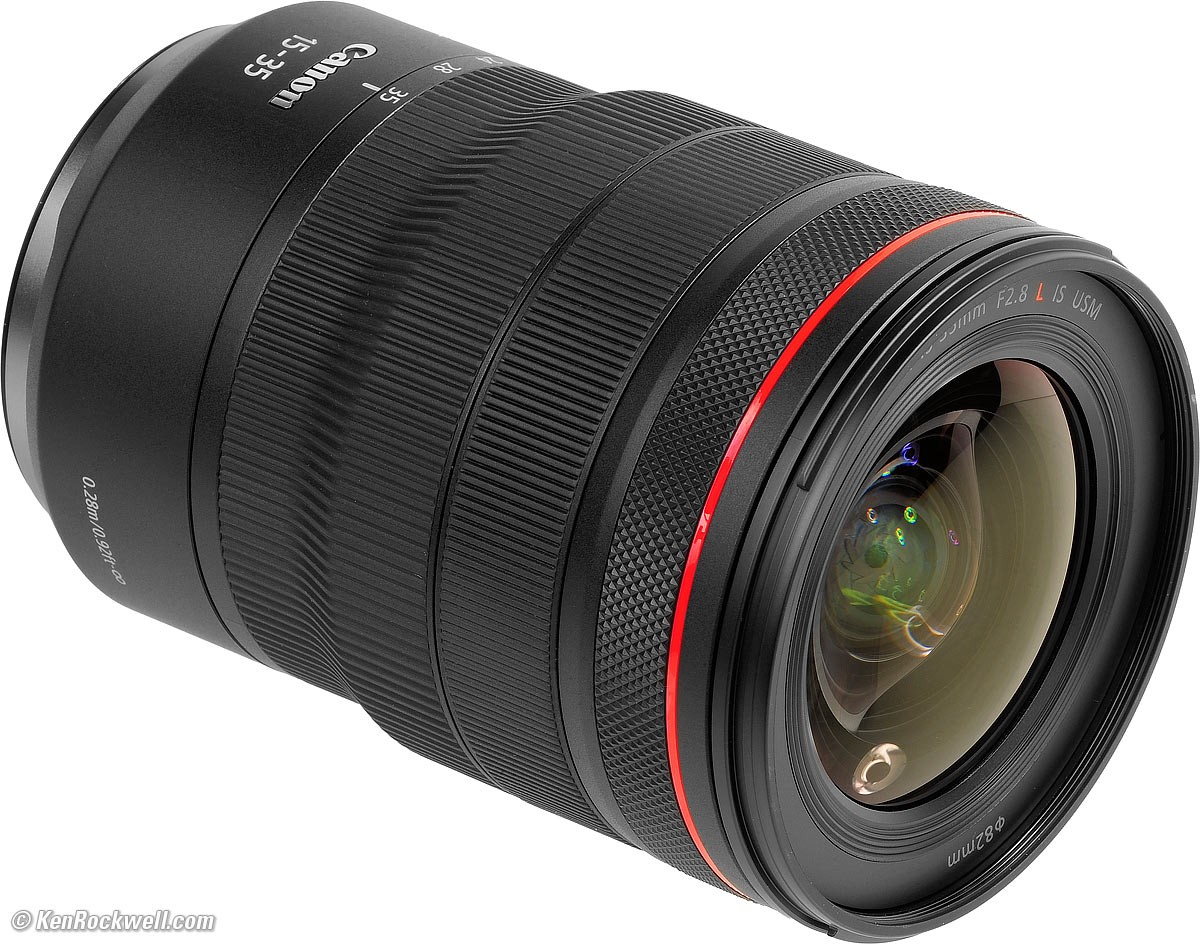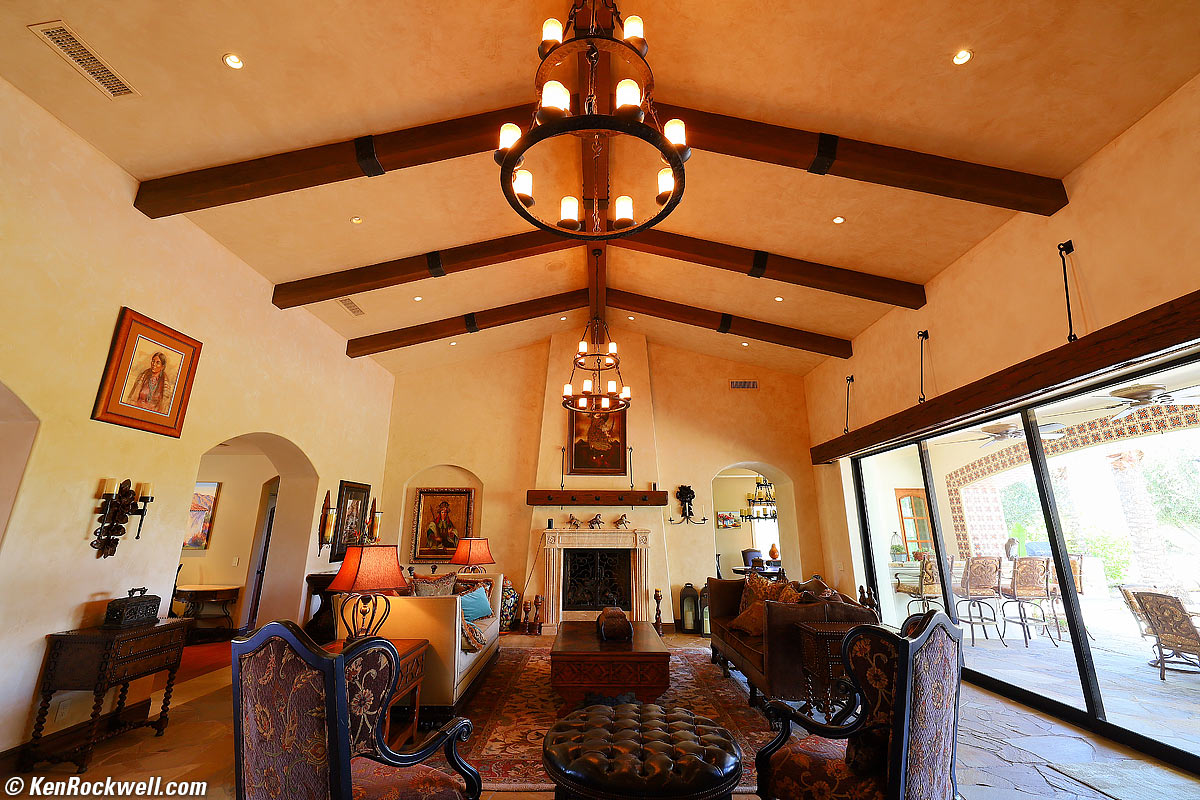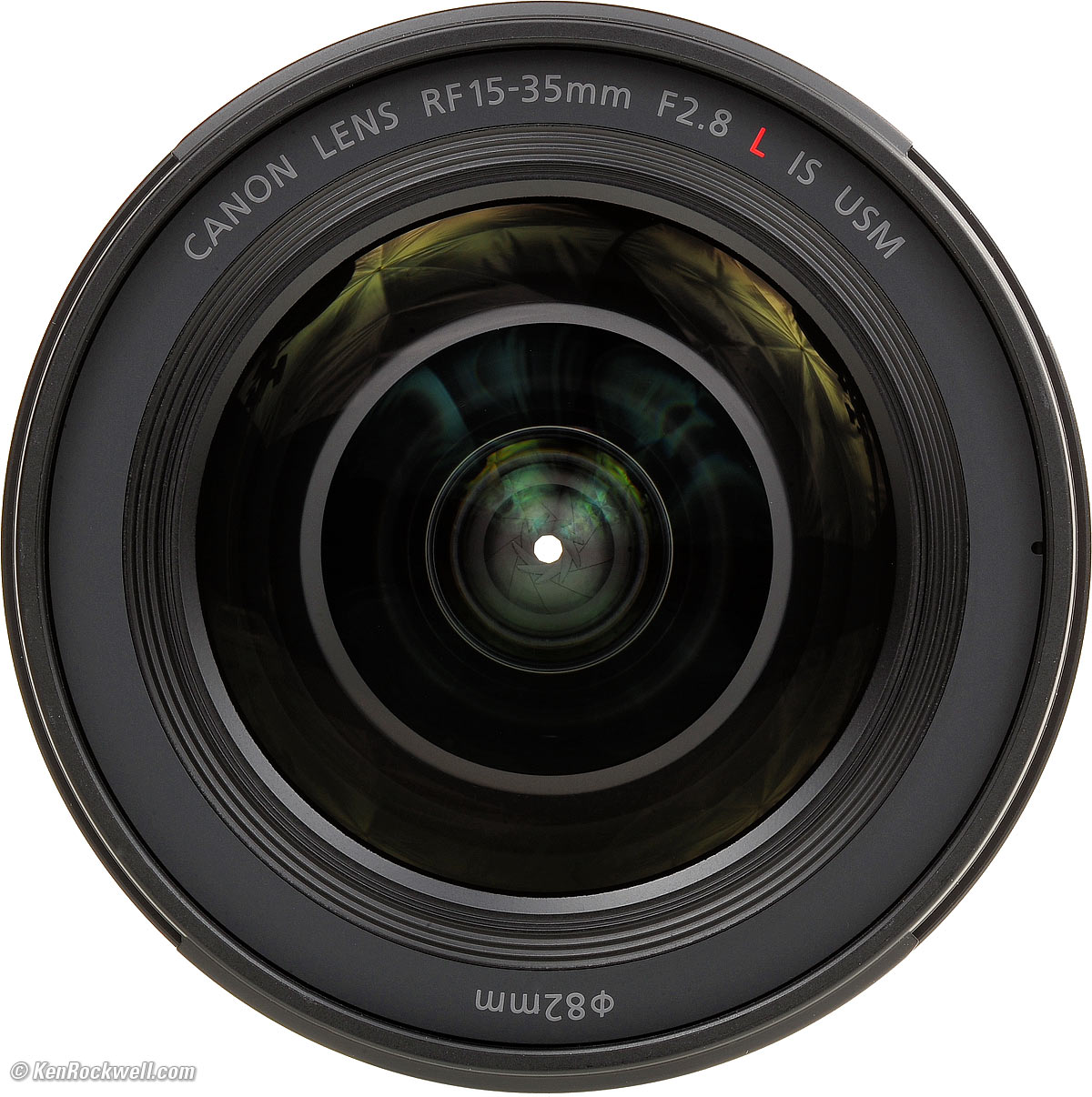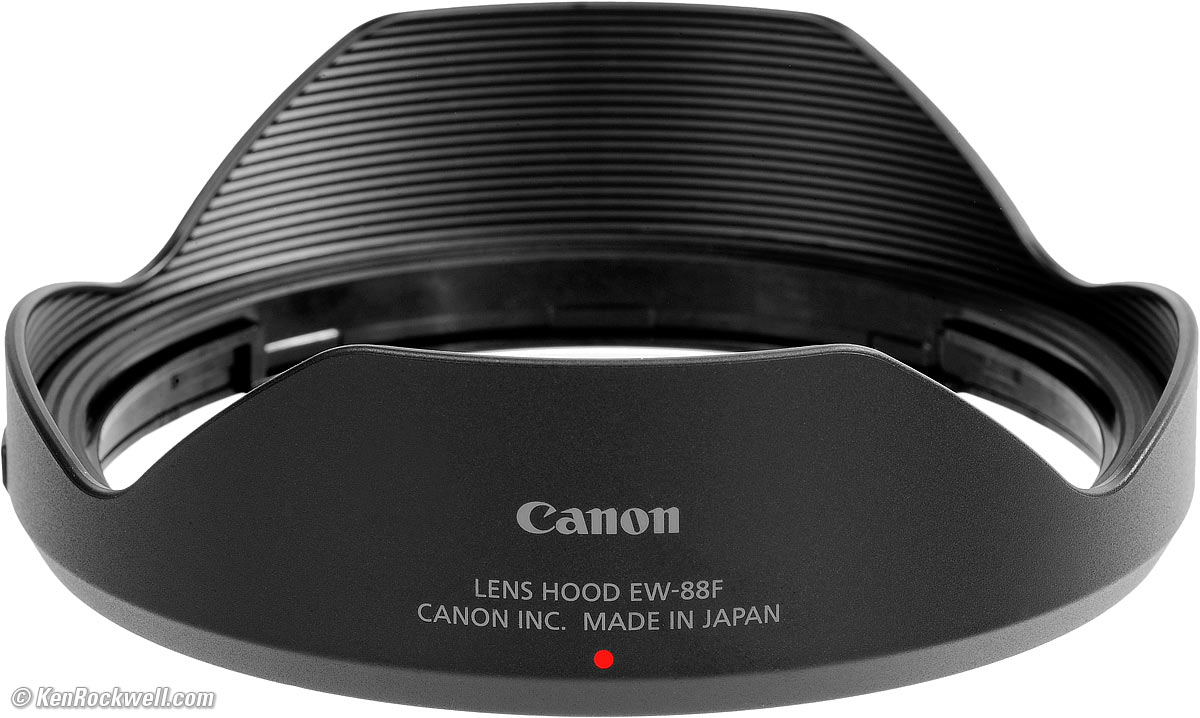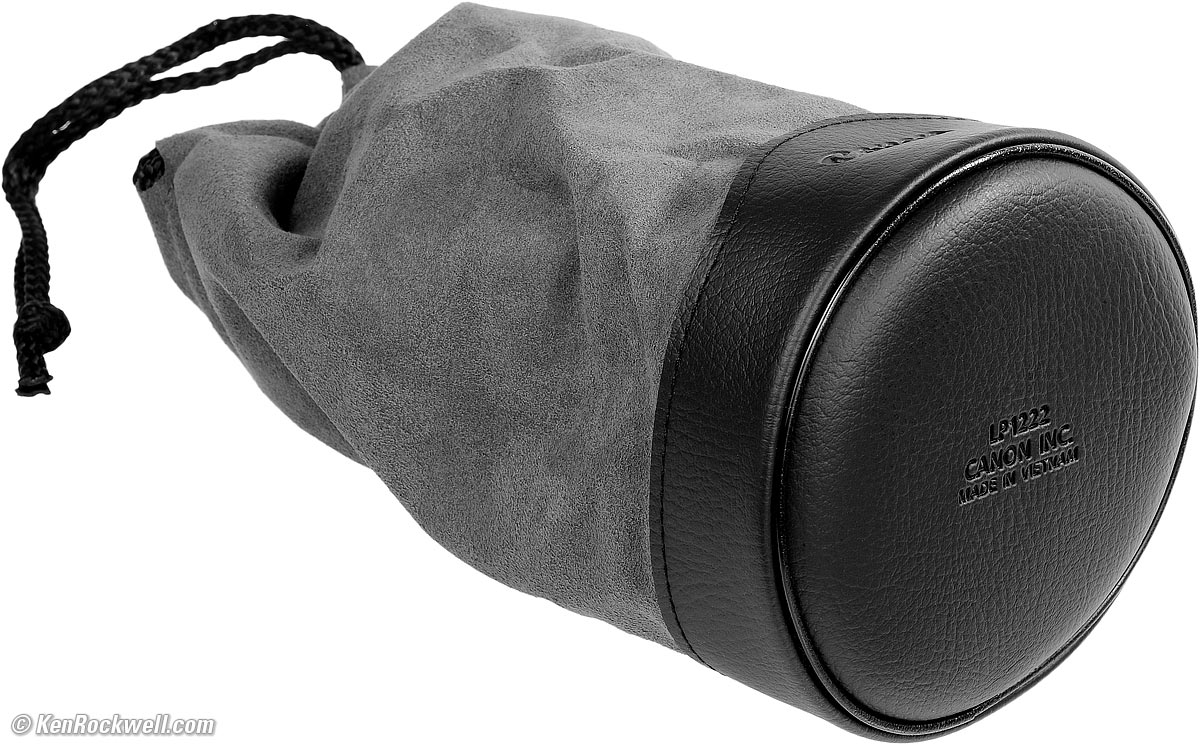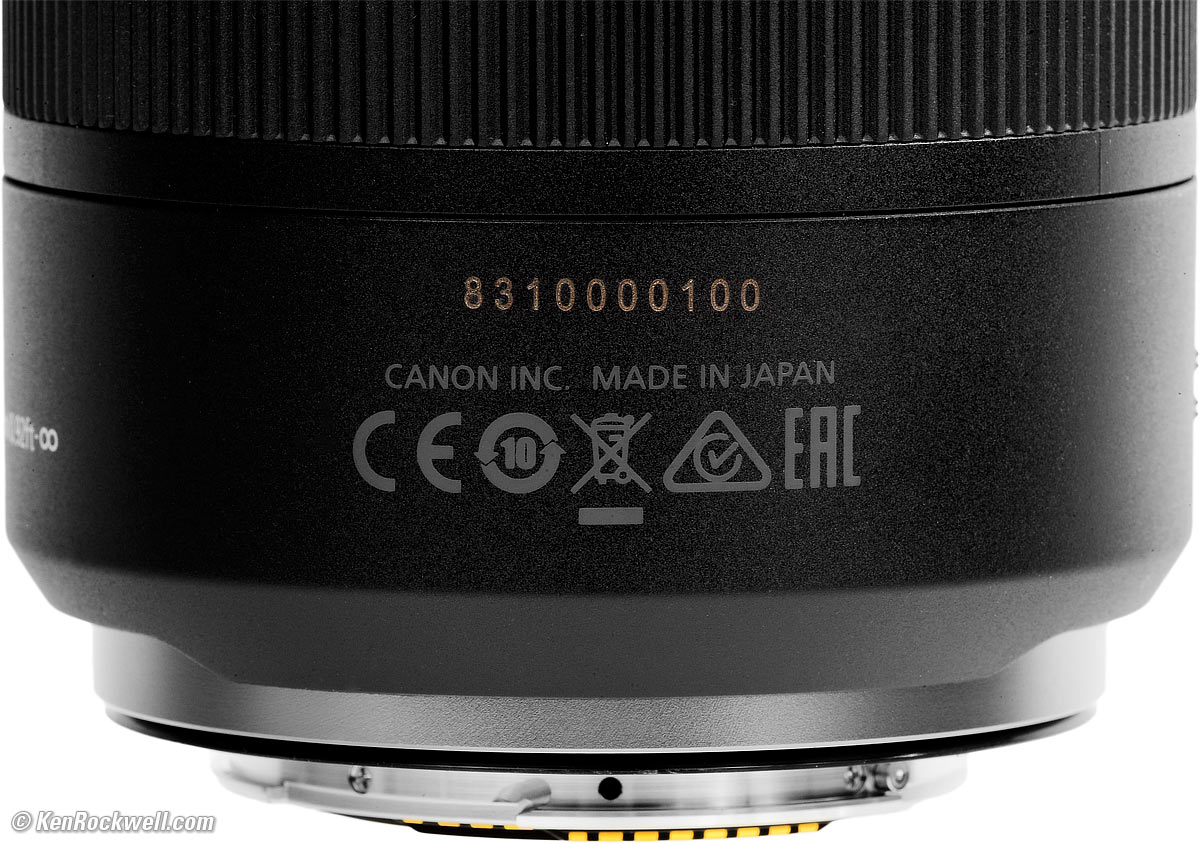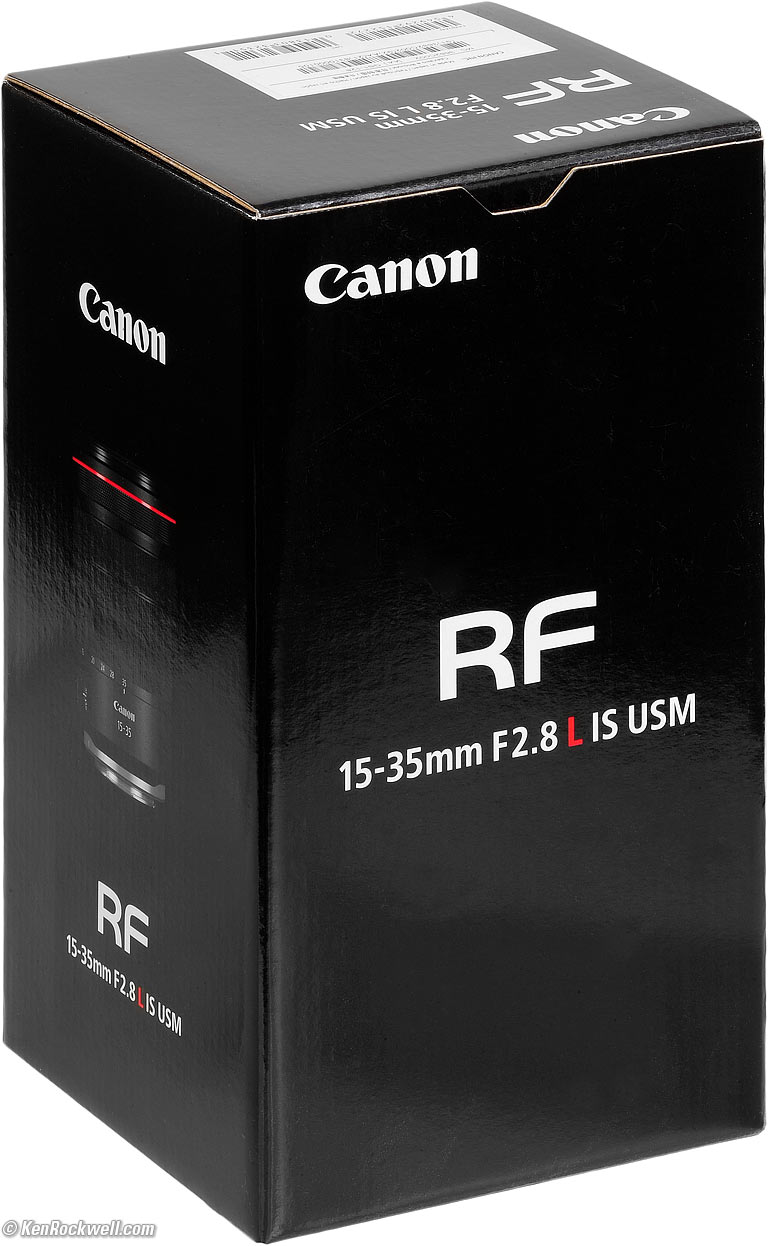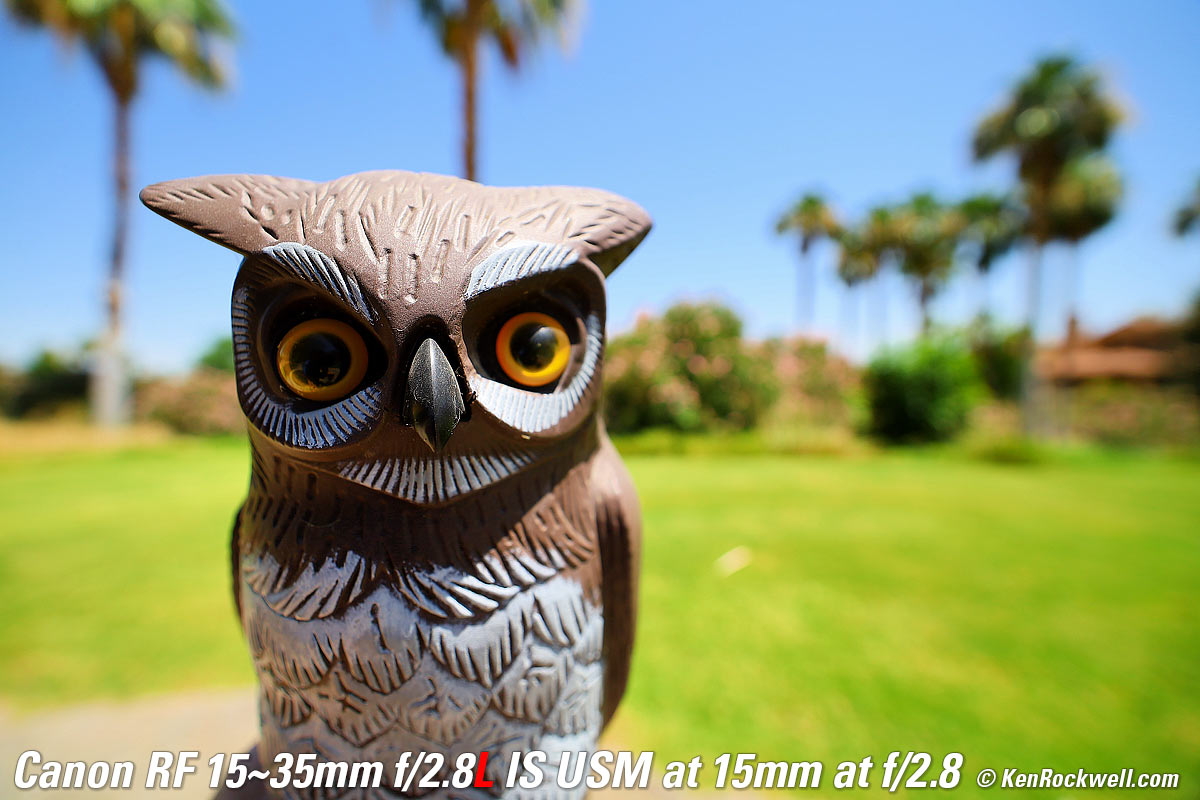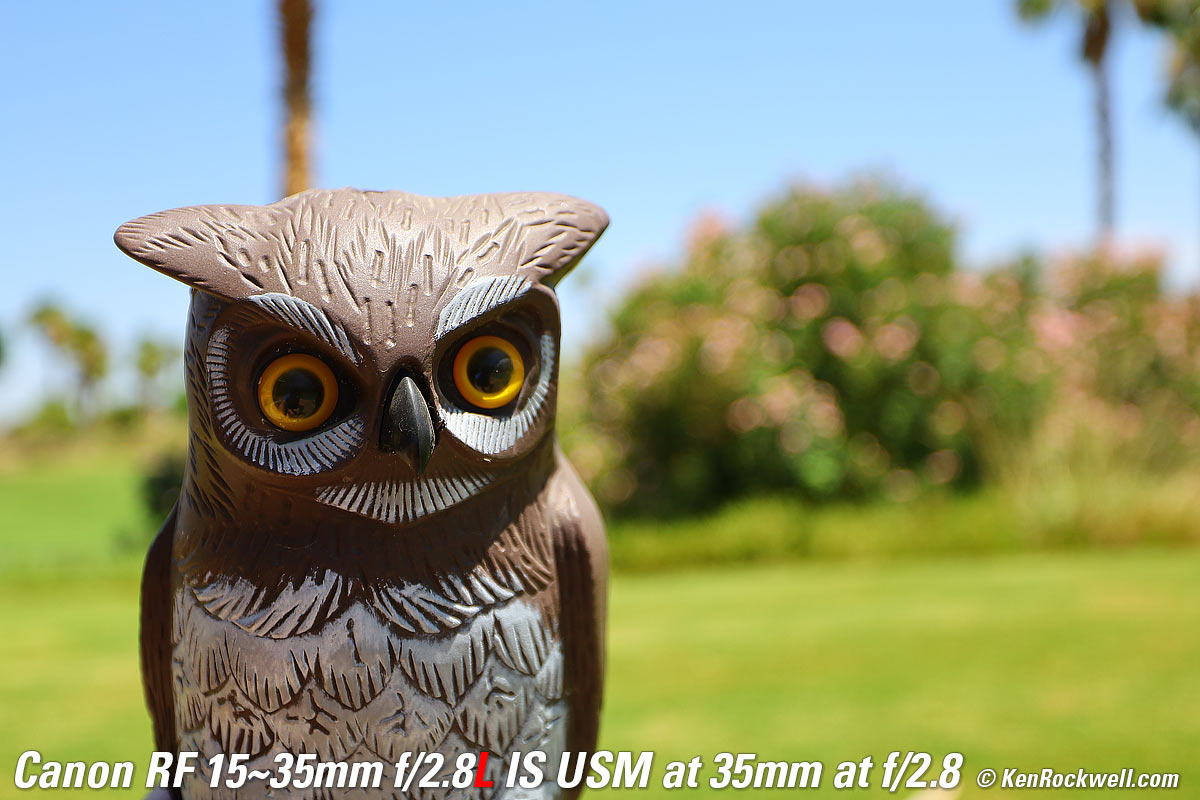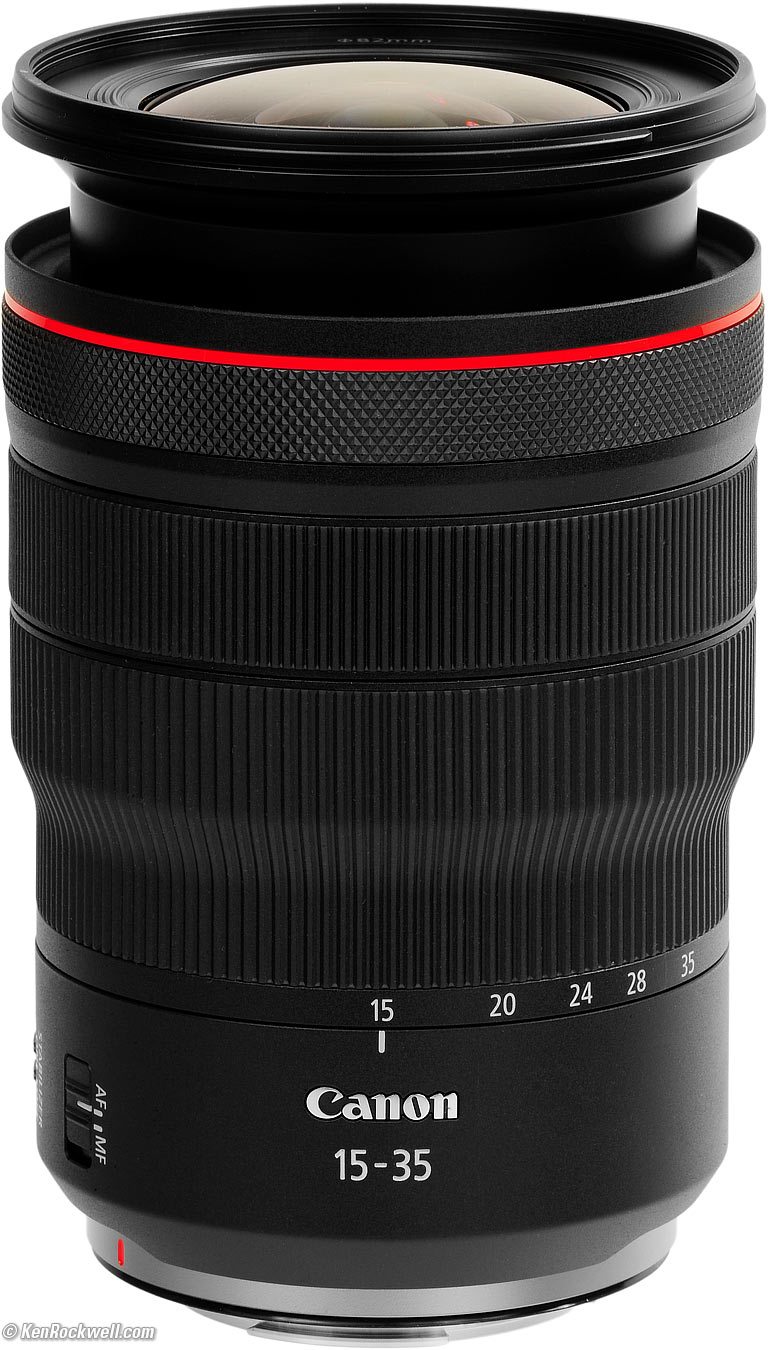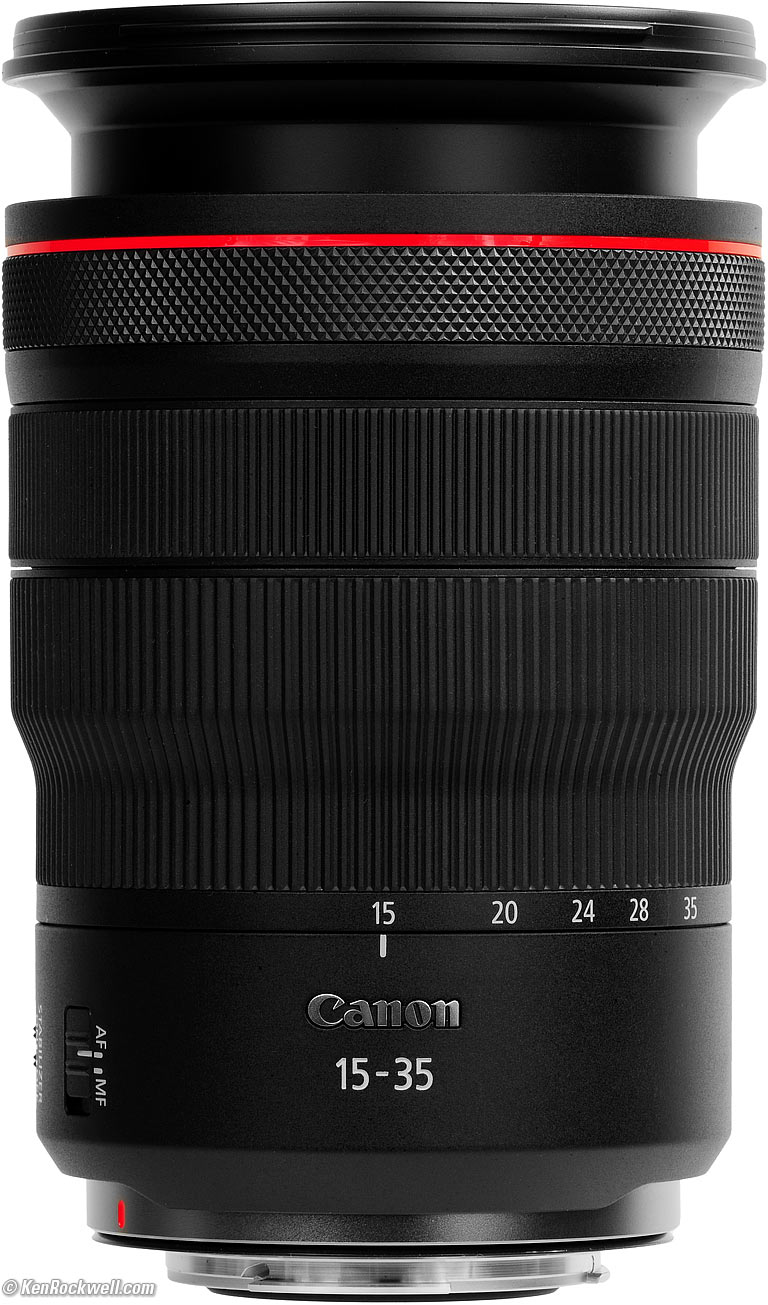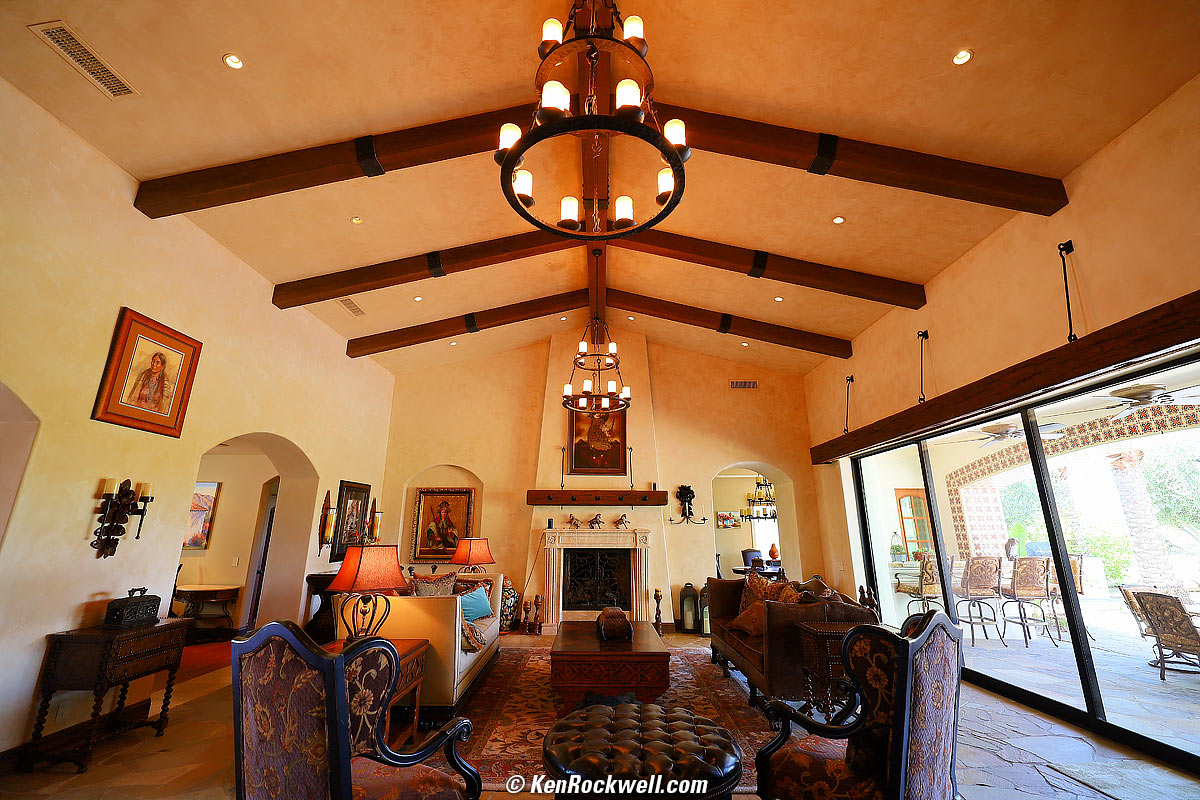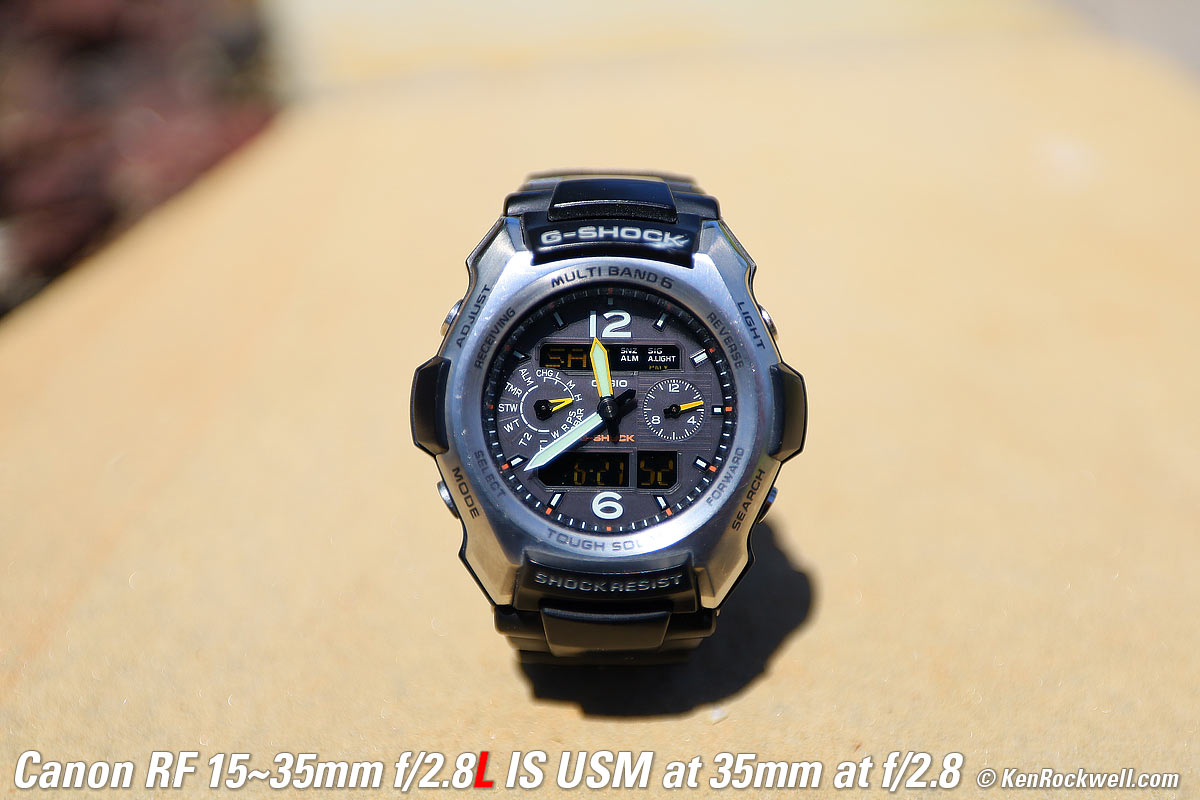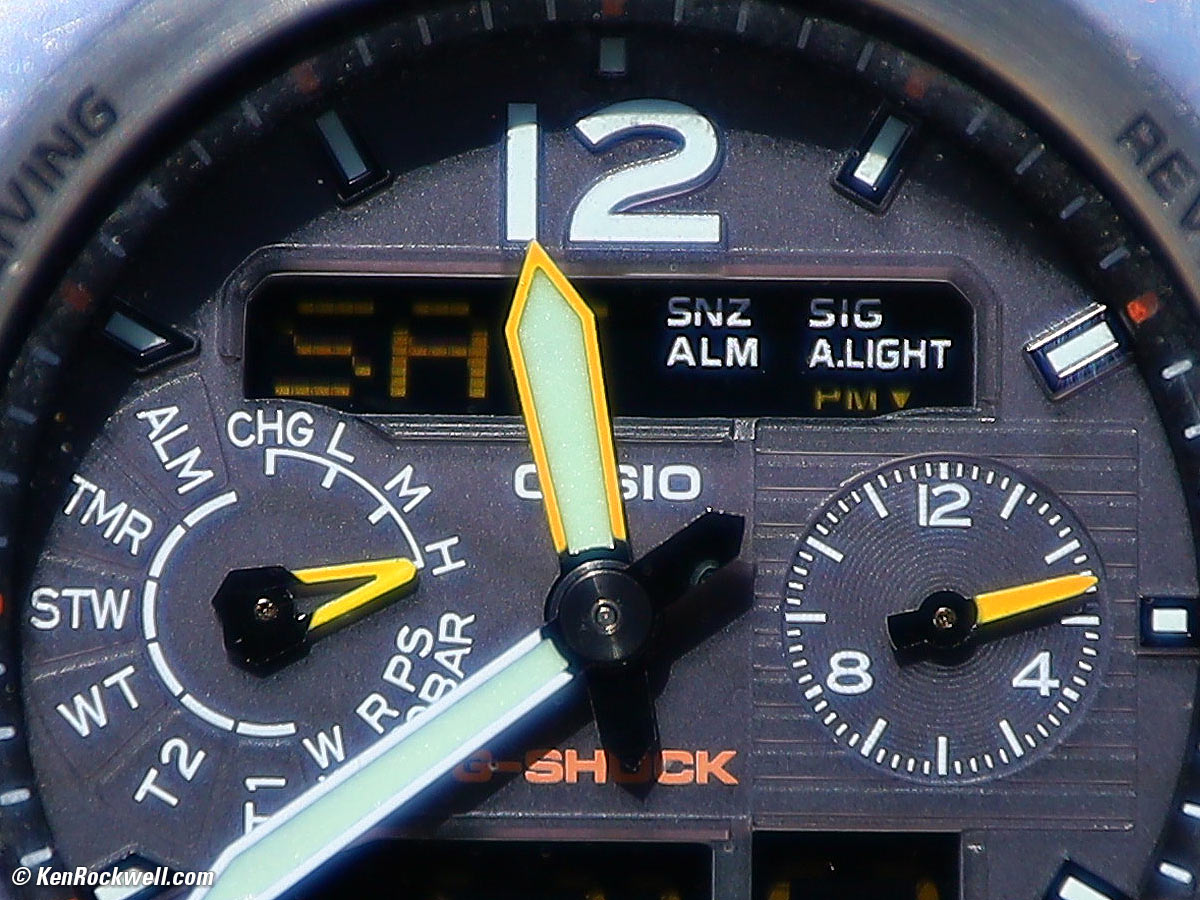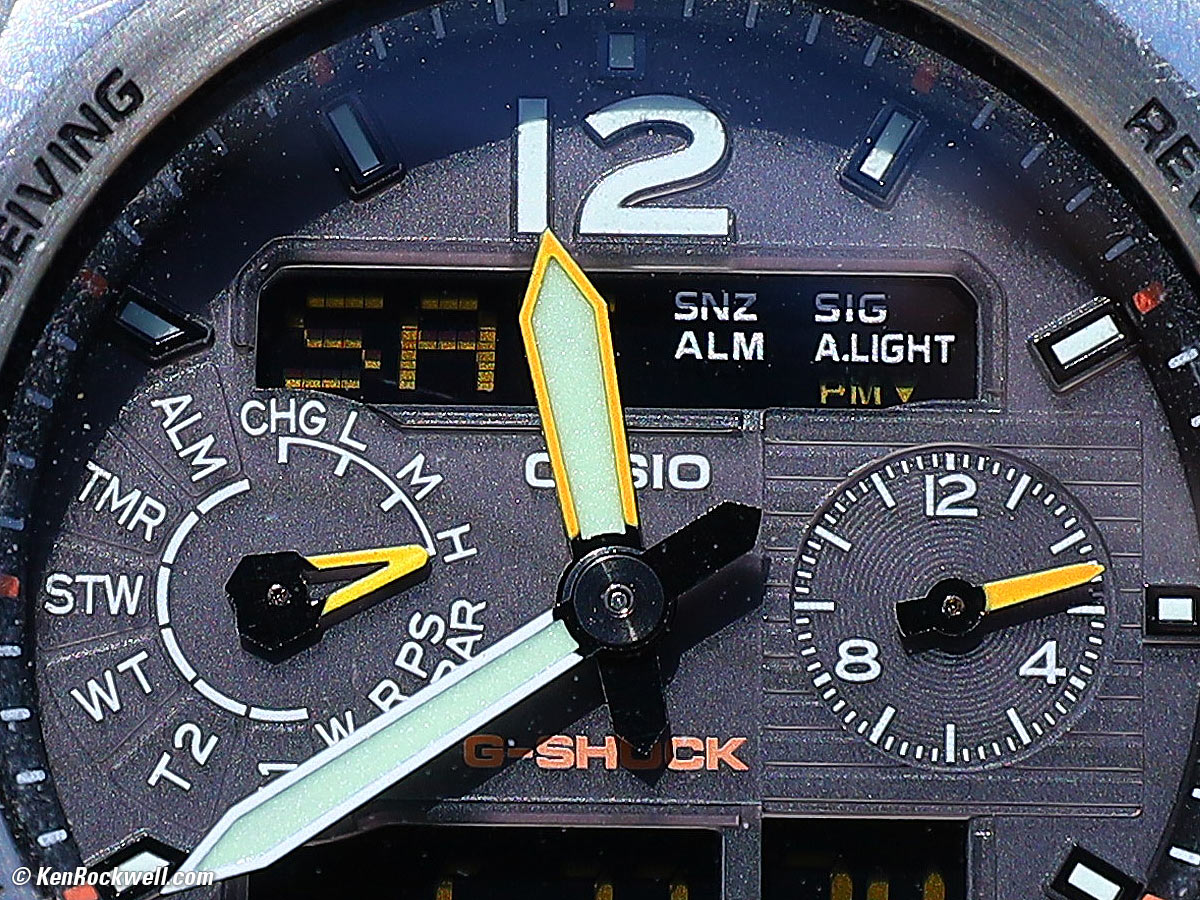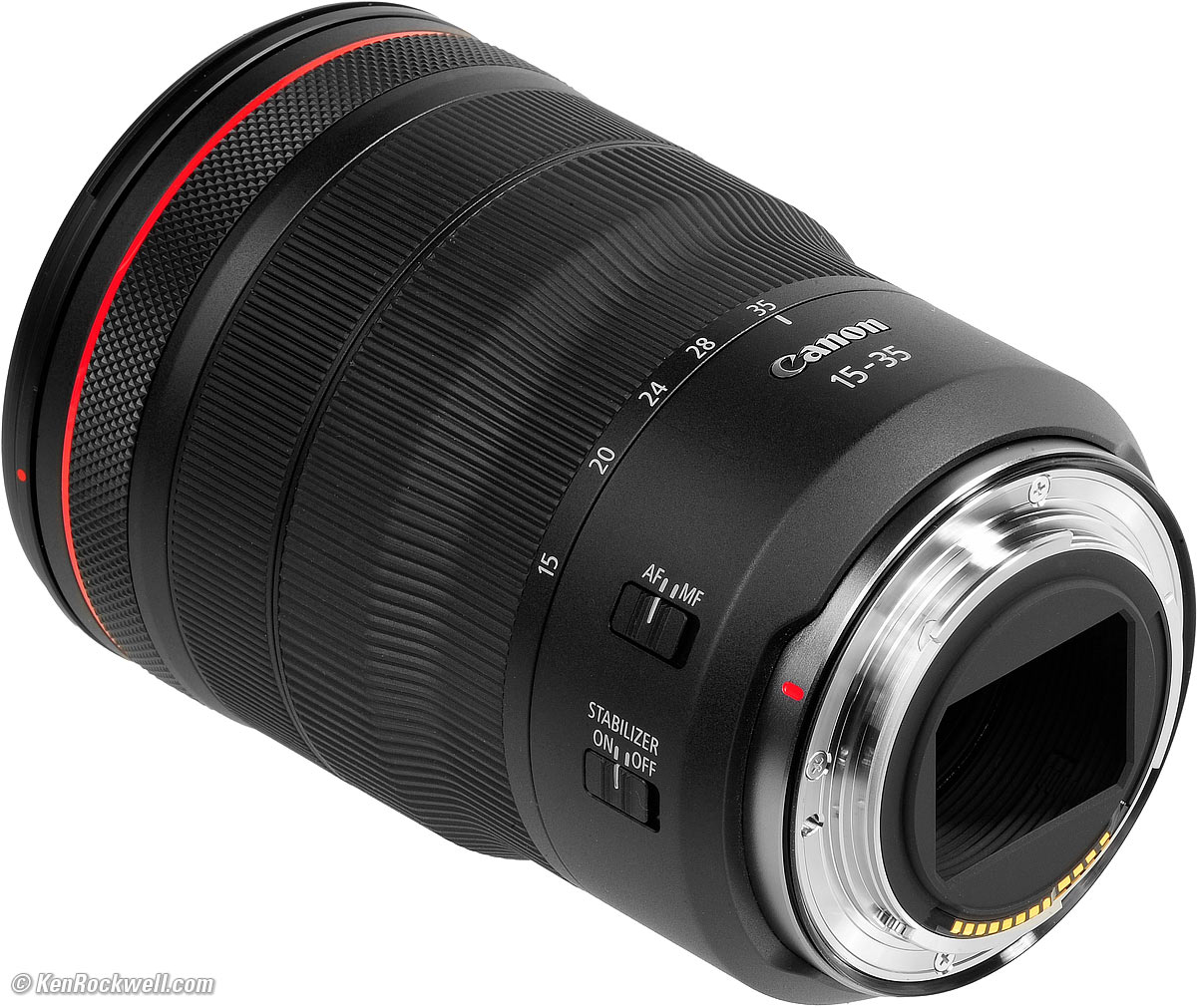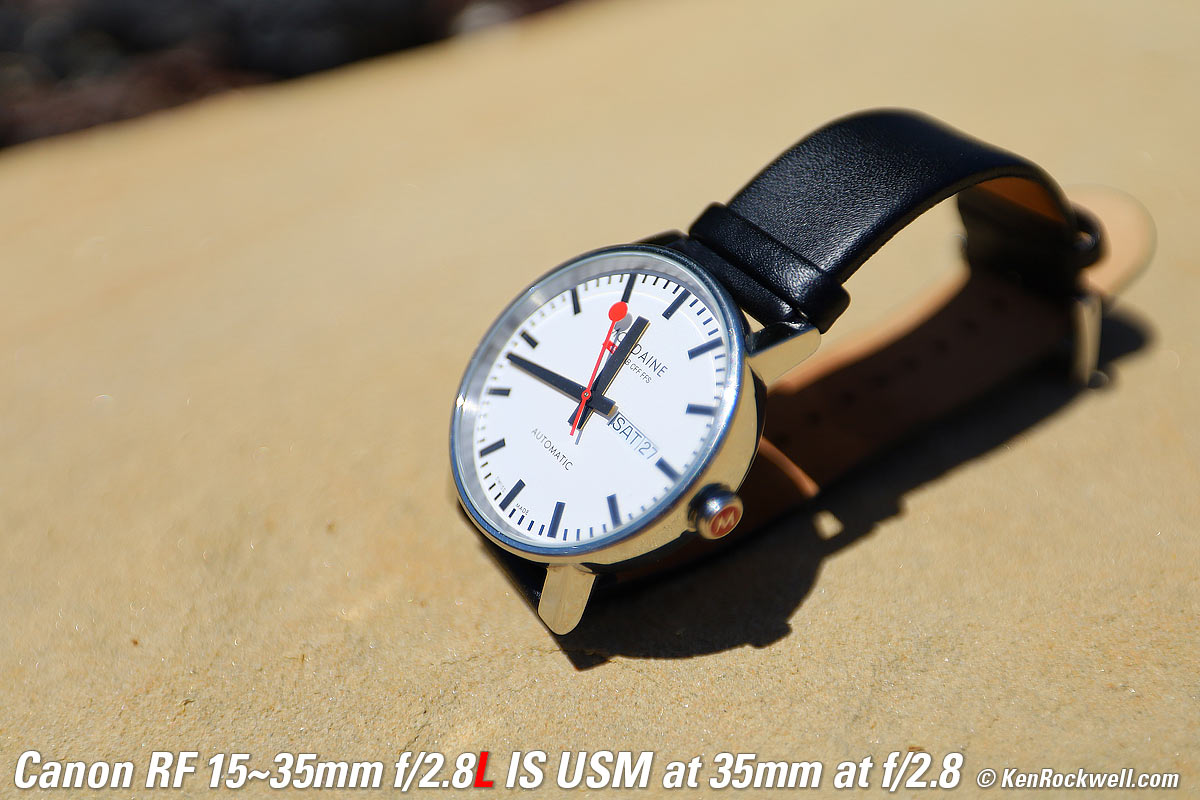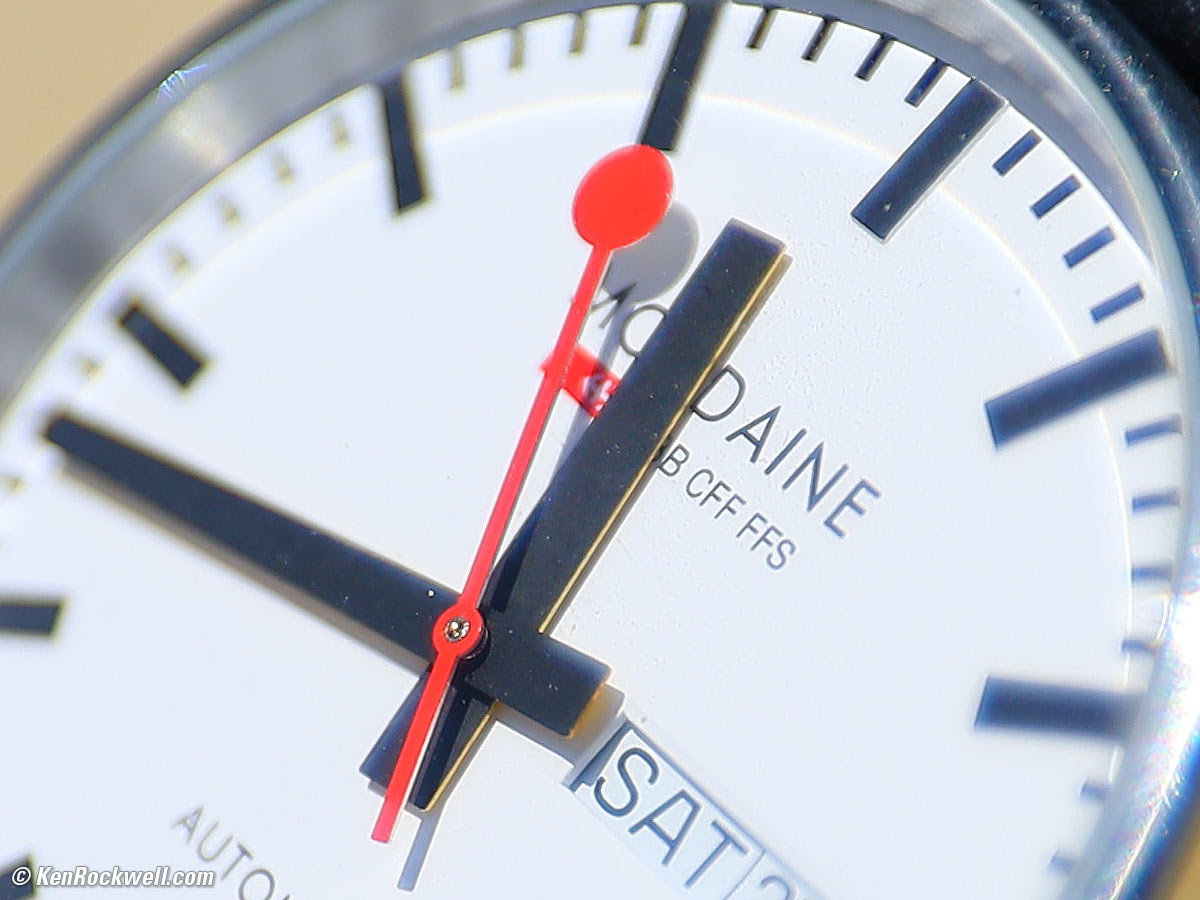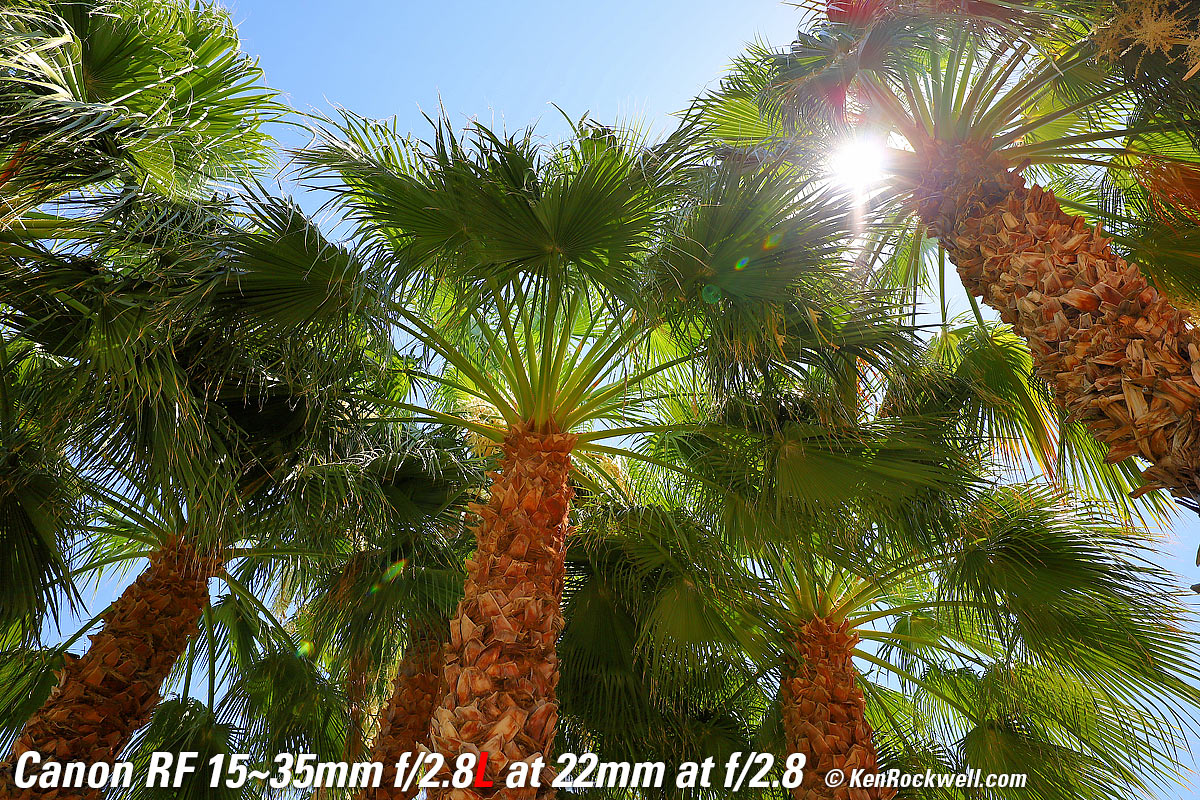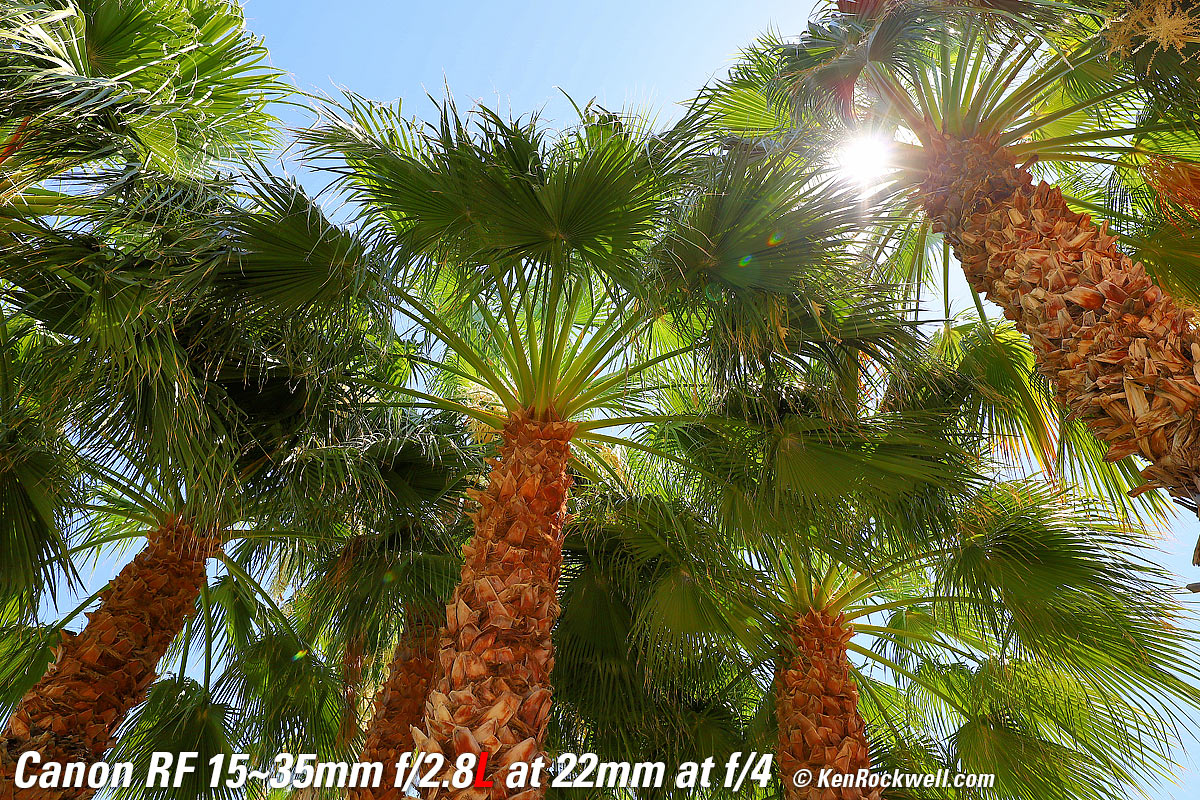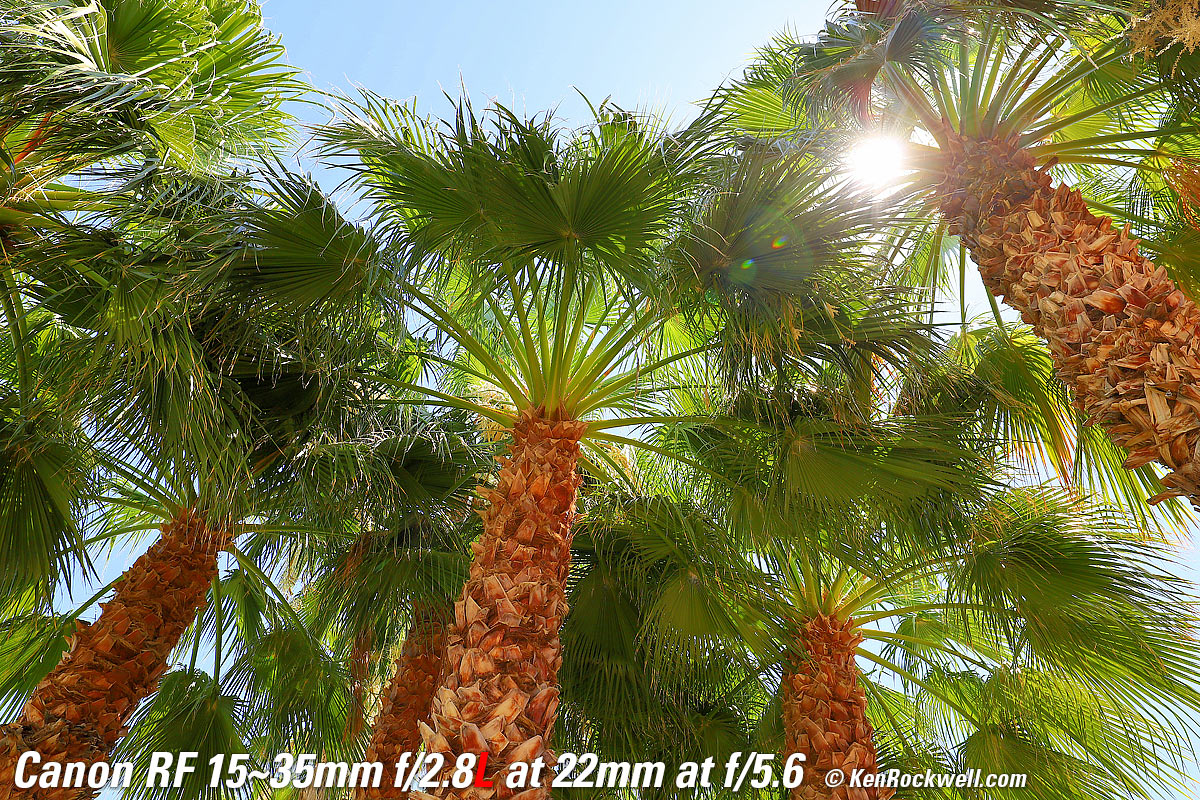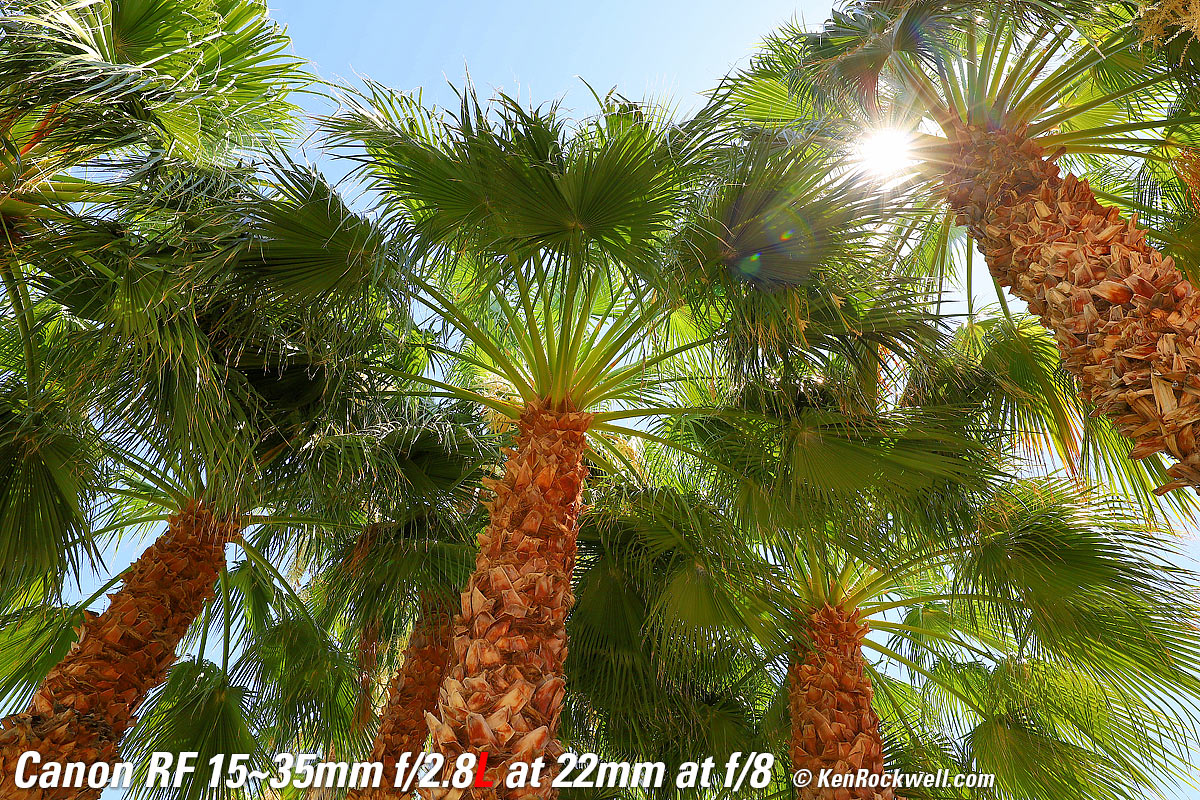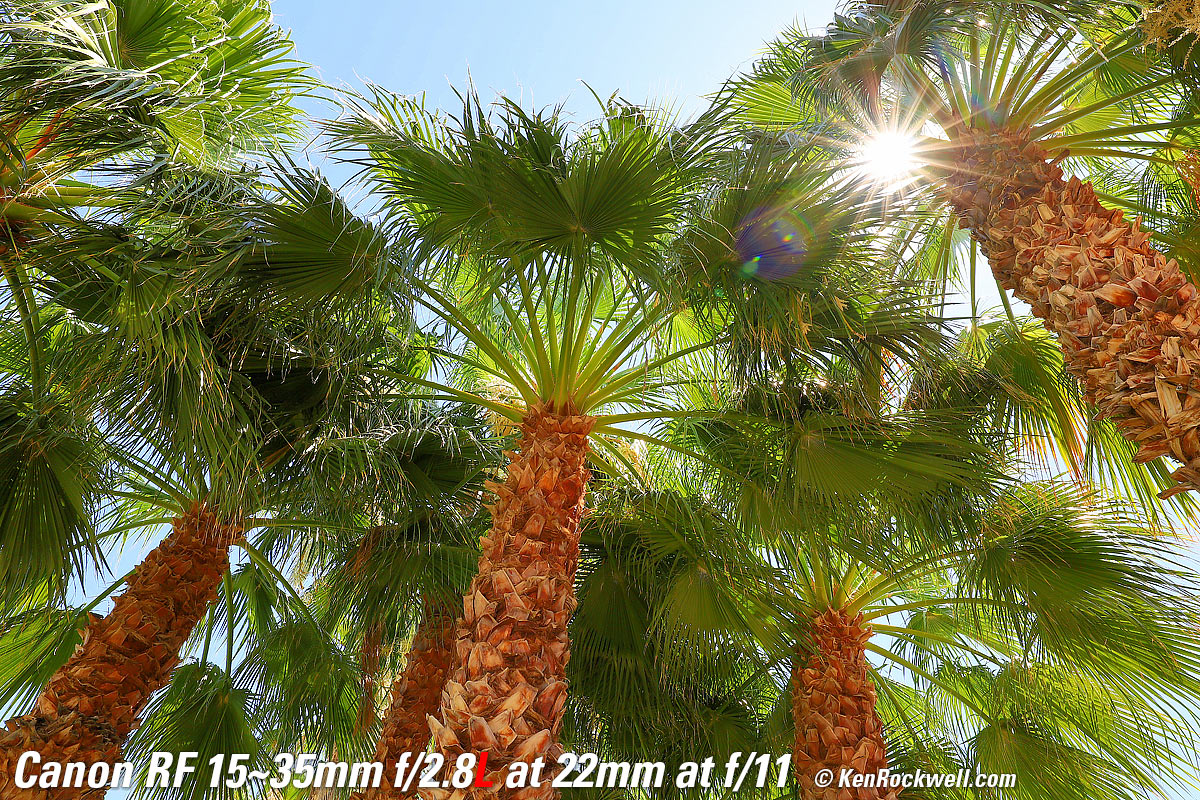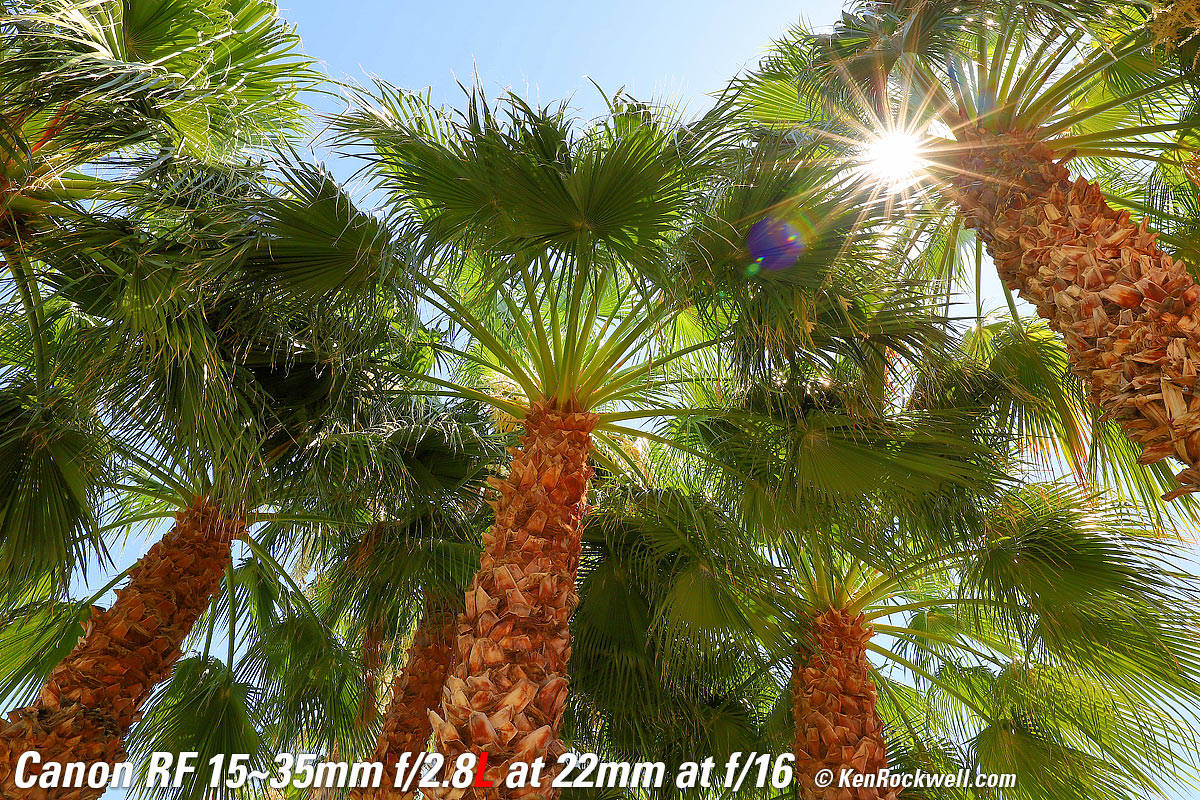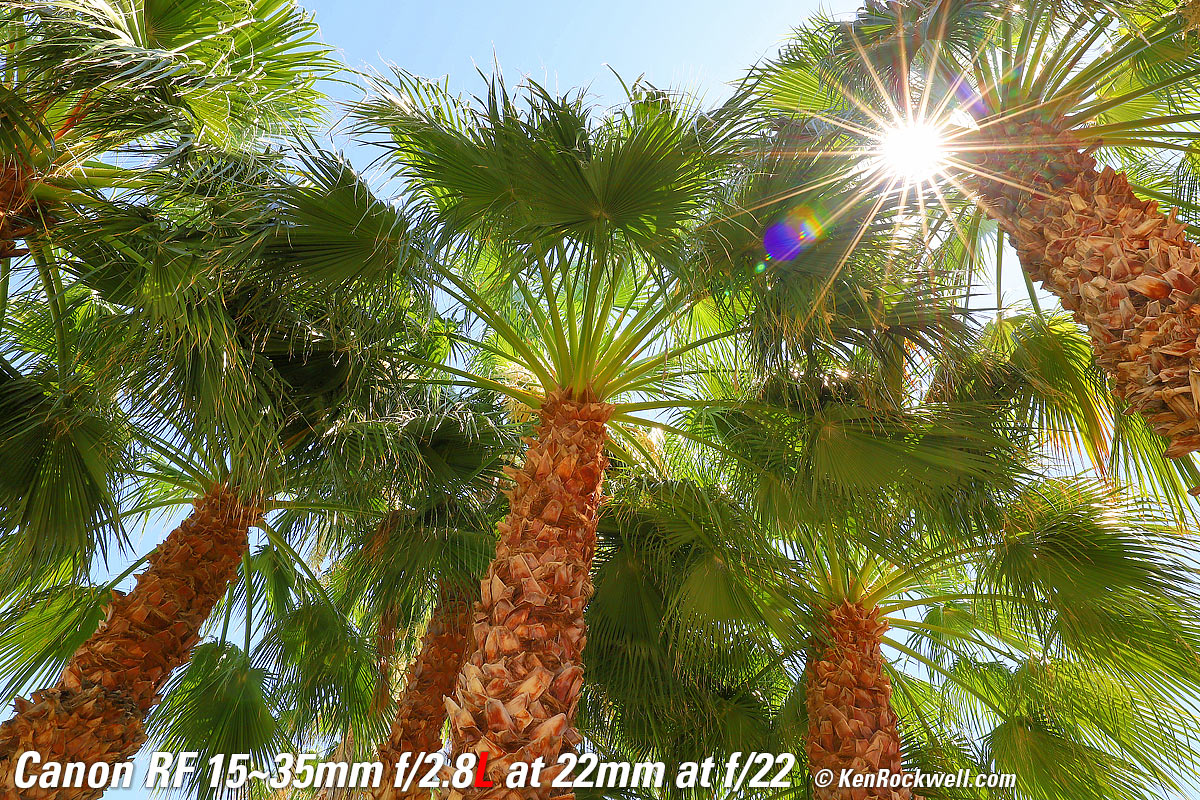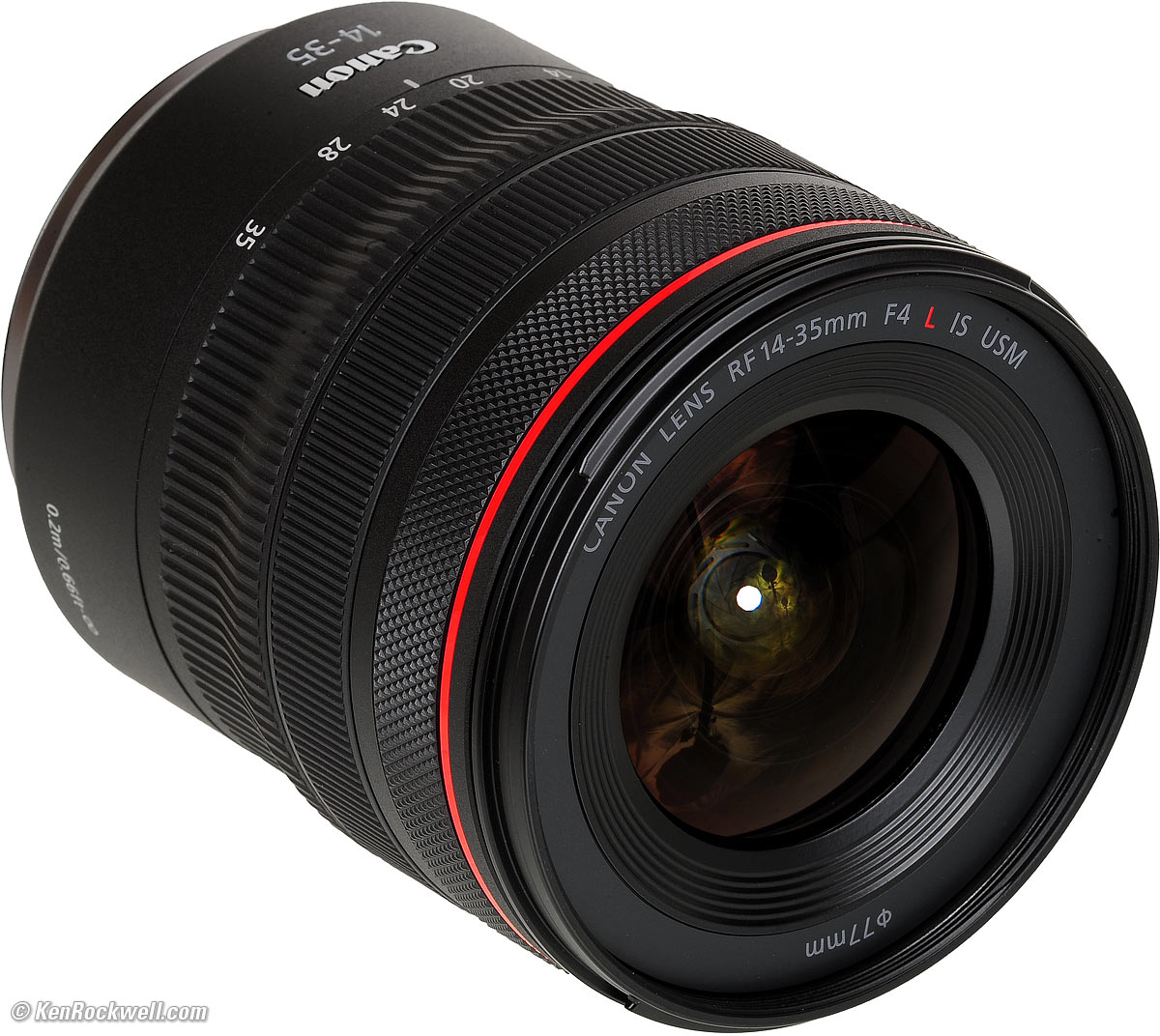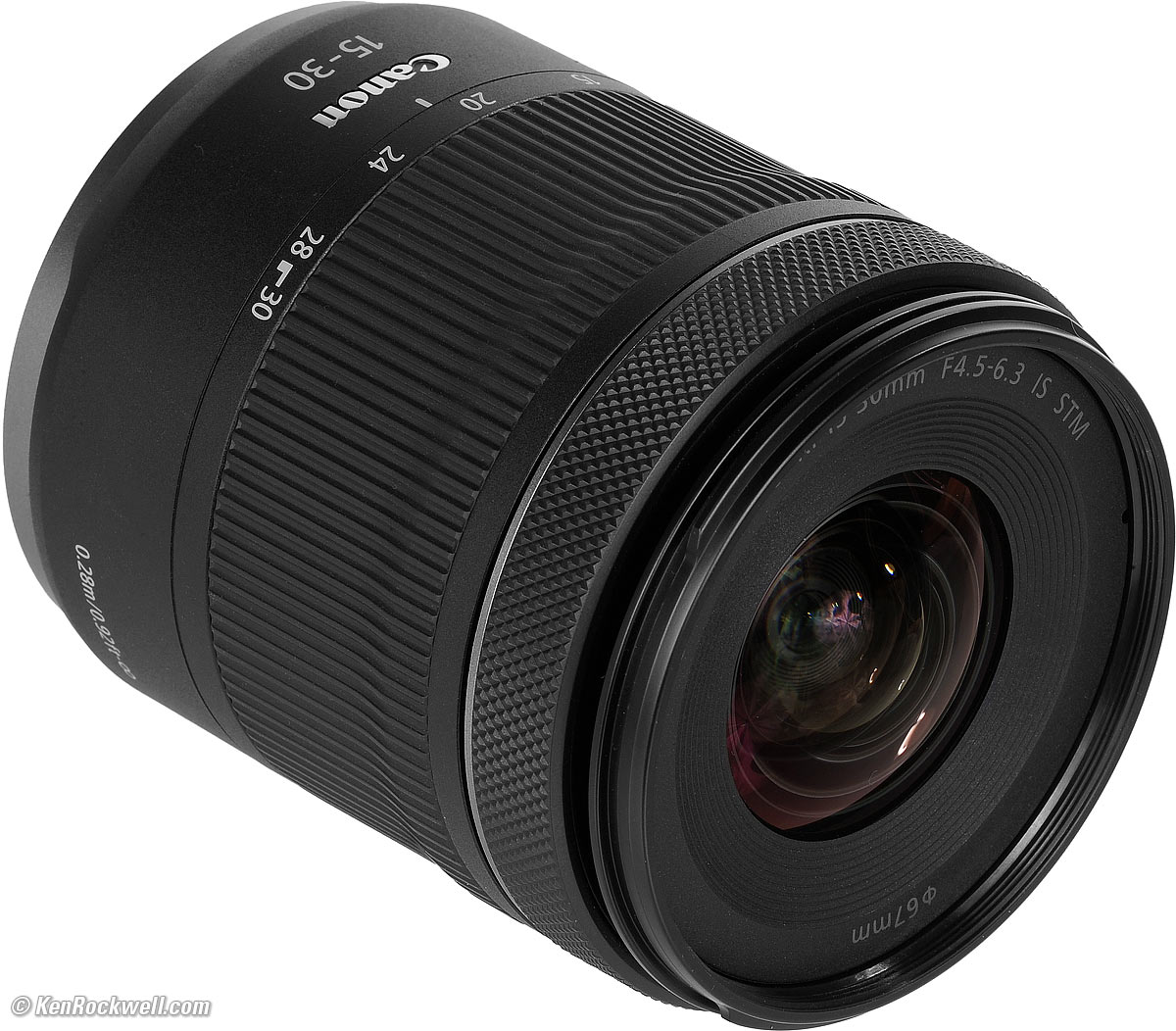Canon 15‑35mm f/2.8L IS
RF USM
Full-Frame Mirrorless
World's Best Fast Ultrawide Zoom
Sample Images Intro Compatibility
Compared User's Guide Recommendations
R3 R5 R5C R6 II R6 R R8 RP R7 R10 R50 R100
Bodies Compared RF Lenses EF Lenses Flash
Canon RF 15-35mm f/2.8L IS USM (82mm filters, 29.4 oz./834 g, 0.92'/0.28m/11" close focus, $1,999). bigger. I got mine at B&H. I'd also get it at Adorama, at Amazon or at Crutchfield, or used at eBay if you know How to Win at eBay.
This all-content, junk-free website's biggest source of support is when you use those or any of these links to approved sources when you get anything, regardless of the country in which you live. Thanks for helping me help you! Ken.
October 2022 Canon Reviews Mirrorless RF Lenses EF Lenses Flash All Reviews
Canon RF 14-35mm f/4L IS USM Review
Canon RF 15-30mm IS STM Review
Sample Images top
Sample Images Intro Compatibility
Compared User's Guide Recommendations
These are just snapshots and there are many more throughout the review; my real work is in my Gallery.
These are shot as NORMAL JPGs; no FINE JPGs or RAW CR3 files were used or needed.
Seven Palms Oasis, 7:09 PM, 24 June 2020. Canon EOS-RP, Canon RF 15-35mm f/2.8 L IS at 21mm wide-open at f/2.8 at 1/640 at Auto ISO 100 (LV 12.4), exactly as shot. bigger or camera-original © JPG file.
This images says it all: even shot wide-open at f/2.8, the 15-35/2.8 is stunningly sharp from corner-to-corner on full frame, far ahead of Nikon's slower, softer, offshored and pathetically wimpy Z 14-30mm f/4.
Here's a crop from the top-right corner, with perfect pixel-to-pixel sharpness:
1,200 × 900 pixel crop (5.2× magnification) from above. bigger or camera-original © JPG file.
If this 1,200 × 900 pixel crop is about 3" (7.5cm) wide on your screen, then the complete image printed at this same magnification would be about 11 × 16" (0.9 × 1.3 feet or 25 × 40 cm).
If this 1,200 × 900 pixel crop is about 6" (15cm) wide on your screen, then the complete image printed at this same high magnification would be about 21 × 31" (1.7 × 2.6 feet or 50 × 80 cm).
If this 1,200 × 900 pixel crop is about 12" (30cm) wide on your screen, then the complete image printed at this same extreme magnification would be about 42 × 62" (3.5 × 5.2 feet or 1.05 × 1.6 meters).
I could end this review now and save myself a lot of time, but noooooo, you people won't leave it at that. This is an outstanding lens; lenses never used to be able to pass these torture tests where I shoot the lens at it's worse possible dark-light settings in broad daylight. Remember that at f/2.8 there is also very little depth-of-field and plenty in this image is simply out-of-focus.
Fine Spanish Home, 2:30 PM, 26 June 2020. Canon EOS-RP, Canon RF 15-35mm f/2.8 L IS at 15mm at f/8 at 1/3 of a second at ISO 100, +⅔ stop exposure compensation (LV 7.6), Perfectly Clear. bigger, full-resolution or camera-original © JPG file.
Introduction top
Sample Images Intro Compatibility
Compared User's Guide Recommendations
|
I buy only from these approved sources. I can't vouch for ads below. |
The RF 15-35mm f/2.8L is a big, heavy professional ultrawide zoom for Canon's EOS-R mirrorless system.
It's the world's best ultra-ultrawide zoom because of its outstandingly superior optics, its great ergonomics, super-fast autofocus, ability to use normal 82mm screw-in filters and the best Image Stabilization I have ever seen, letting me get sharp shots often at a full-second hand-held!
I got my RF 15-35mm at B&H. I'd also get it at Adorama, at Amazon or at Crutchfield, or used at eBay if you know How to Win at eBay.
New intro top
 Canon's first ultra-ultrawide lens for its full-frame mirrorless system.
Canon's first ultra-ultrawide lens for its full-frame mirrorless system.
 Canon's first f/2.8 ultrawide with Image Stabilization.
Canon's first f/2.8 ultrawide with Image Stabilization.
 "Nano Ultrasonic Focus Motor (USM)" is tiny and combines the speed of Canon's professional ring USM with the quietness of stepper motor (STM) lenses.
"Nano Ultrasonic Focus Motor (USM)" is tiny and combines the speed of Canon's professional ring USM with the quietness of stepper motor (STM) lenses.
Good intro top
 Outstanding optics: the sharpest ultrawide zoom I've ever used. Perfect pixel-to-pixel sharpness even in the far corners wide-open.
Outstanding optics: the sharpest ultrawide zoom I've ever used. Perfect pixel-to-pixel sharpness even in the far corners wide-open.
 The best Image Stabilization I have ever tested.
The best Image Stabilization I have ever tested.
 Superb sunstars, which are important in ultrawide lenses because the sun and other light sources often make it into the image.
Superb sunstars, which are important in ultrawide lenses because the sun and other light sources often make it into the image.
 Takes normal 82mm screw-in filters.
Takes normal 82mm screw-in filters.
 Super-fast autofocus.
Super-fast autofocus.
 Crud-resistant fluorine coatings.
Crud-resistant fluorine coatings.
 Dust, drip, dirt and moisture resistant.
Dust, drip, dirt and moisture resistant.
 Two control rings in addition to the zoom ring.
Two control rings in addition to the zoom ring.
 Made in Japan.
Made in Japan.
 100% U.S.A.-based high-quality technical support at (800) OK-CANON.
100% U.S.A.-based high-quality technical support at (800) OK-CANON.
Bad intro top
 Nothing, other than being big (82mm filters), heavy and expensive.
Nothing, other than being big (82mm filters), heavy and expensive.
Missing intro top
 Nothing; it comes with a case and hood, has three control rings (mechanical zoom and two additional electronic control rings) and has dedicated switches for AF/MF and stabilization ON/OFF.
Nothing; it comes with a case and hood, has three control rings (mechanical zoom and two additional electronic control rings) and has dedicated switches for AF/MF and stabilization ON/OFF.
Compatibility top
Sample Images Intro Compatibility
Compared User's Guide Recommendations
I got my RF 15-35mm at B&H. I'd also get it at Adorama, at Amazon or at Crutchfield, or used at eBay if you know How to Win at eBay.
This lens only works on Canon's EOS-R series of mirrorless cameras.
It will not even mount on any other camera.
Specifications top
Sample Images Intro Compatibility
Compared User's Guide Recommendations
I got my RF 15-35mm at B&H. I'd also get it at Adorama, at Amazon or at Crutchfield, or used at eBay if you know How to Win at eBay.
Name specifications top
Canon calls this the Canon RF 15-35mm f/2.8 L IS USM:RF: Works only on Canon's EOS-R Mirrorless cameras.
L: Expensive as L.
IS: Image Stabilization.
USM: Ultrasonic Autofocus Motor.
It's also model number RF15-3528LIS, product code 3682C002 (3682C001 in Japan) and JAN code 4549292-152272.
Optics specifications top
Canon RF 15-35mm Internal Optical Construction. Aspherical and UD elements. Red Box: Image Stabilizer group. Dashed lines: Sub-Wavelength Coating and Air-Sphere Coatings.
16 elements in 12 groups.
2 UD extra-low dispersion elements, which help reduce secondary axial chromatic aberration.
3 molded glass aspherical elements
Fluorine coating to resist dirt and smudges.
Air-Sphere and Sub-Wavelength continuously-variable index of refraction coatings for ghost reduction.
It's a mild "pumper" zoom. The front section moves out about a centimeter (a half of an inch) as you zoom-out from 35mm to 15mm.
Filters specifications top
Plastic 82 mm filter thread.
Coverage specifications top
Full-Frame (24 x 36mm) and APS-C (15 x 23mm).
Diaphragm specifications top
15-35mm f/2.8L at about f/16. bigger.
9 rounded blades.
Electronically actuated.
Stops down to f/22.
Angles of View, Full Frame specifications top
110.52º ~ 63.44º diagonal.
100.39º ~ 54.43º horizontal.
77.32º ~ 37.85º vertical.
Autofocus specifications top
Nano-USM motor.
Full-time manual-focus override claimed, but only works some of the time depending on how you have your camera set.
Focus Scale specifications top
Not on lens, but can be in finder.
Infinity Focus Stop specifications top
No.
Depth of Field Scale specifications top
No.
Infrared Focus Index specifications top
No.
Close Focus specifications top
0.92 feet (0.28 meters or 11 inches) from the image plane; even closer to the front of the lens.
Maximum Reproduction Ratio specifications top
1:4.76 (0.21×).
Reproduction Ratio Scale specifications top
No.
Image Stabilizer specifications top
Rated 5 stops improvement.
Hood specifications top
Canon EW-88F Hood for RF 15-35mm f/2.8L IS USM. bigger.
EW-88F included.
Case specifications top
Canon LP-1222 Carry Sack. bigger.
LP-1222 carry sack included.
Size specifications top
3.48" Ø maximum diameter × 4.99" minimum extension from flange.
88.5 mm Ø maximum diameter × 126.8 mm minimum extension from flange.
Weight specifications top
29.405 oz. (833.6 g) actual measured weight.
Rated 29.6 oz. (840 g).
Quality specifications top
Canon RF 15-35mm f/2.8L IS USM. bigger.
Made in Japan.
Development Announced specifications top
11 PM Wednesday, 13 February 2019, NYC time.
Product Announced specifications top
28 August 2019.
Promised for specifications top
Late September 2019.
Included specifications top
RF 15-35mm f/2.8L IS USM.
Rear Lens Dust Cap RF (p/n 2962C001).
Canon's Model Numbers specifications top
RF15-3528LIS
Product code 3682C002 (3682C001 in Japan).
JAN code 4549292-152272.
Price, USA specifications top
28 October 2022
$1,999 at B&H, at Adorama, at Amazon or at Crutchfield.
About $1,600 used if you know How to Win at eBay.
July 2022
$2,399 at B&H, at Adorama, at Amazon or at Crutchfield.
About $1,700 used if you know How to Win at eBay.
August 2019 ~ June 2021
Box, Canon RF 15-35mm f/2.8L IS USM. bigger.
Performance top
Sample Images Intro Compatibility
Compared User's Guide Recommendations
Overall Autofocus Manual Focus Breathing Bokeh
Distortion Ergonomics Falloff Filters
Flare & Ghosts Lateral Color Fringes
Lens Corrections Macro Mechanics Sharpness
Spherochromatism Stabilization Sunstars
I got my RF 15-35mm at B&H. I'd also get it at Adorama, at Amazon or at Crutchfield, or used at eBay if you know How to Win at eBay.
Overall performance top
The Canon RF 15-35mm f/2.8L is the world's best ultra-ultrawide zoom because of its superior optics, as well as its great ergonomics and ability to use normal 82mm filters.
Autofocus performance top
Autofocus is super-fast, no problems here!
It's among the fastest-focussing mirrorless lenses I've ever used — maybe the fastest, period.
Manual Focus performance top
Manual focusing is entirely electronic; the manual focus ring isn't connected to anything other than a digital encoder.
How to get manual-focus override.
Focus Breathing performance top
Focus breathing is the image changing size as focused in and out. It's important to cinematographers that the image not breathe because it looks funny if the image changes size as focus gets pulled back and forth between actors. If the lens does this, the image "breathes" by growing and contracting slightly as the dialog goes back and forth.
The image from the RF 15-35mm f/2.8L gets smaller as focussed more closely. The effect is minor at 35mm but strong at 15mm.
Bokeh performance top
Bokeh, the feel, character or quality of out-of-focus areas as opposed to how far out of focus they are, doesn't matter much with ultrawide lenses because nothing ever gets that far out of focus — and especially because if we do headshots with an ultrawide lens, we're looking to make faces look weird in the first place.
If you do look closely, the bokeh is only mediocre. Especially where you can start to see it at 35mm, the blur circles are lighter around their periphery, which can be distracting.
Here are photos from headshot distance wide-open:
Scarecrow Owl, 27 June 2020. Canon EOS RP, Canon RF 15~35mm f/2.8L at 15mm at f/2.8 at 1/1,600 at Auto ISO 100 (LV 13.6). bigger or camera-original © file.
Scarecrow Owl, 27 June 2020. Canon EOS RP, Canon RF 15~35mm f/2.8L at 35mm at f/2.8 at 1/1,250 at Auto ISO 100 (LV 13.4). bigger or camera-original © file.
As always, if you want to throw the background as far out of focus as possible, shoot at f/2.8 at 35mm and get as close as you can.
Distortion performance top
The RF 15-35mm f/2.8L has no visible distortion when shot on Canon's EOS-R series of cameras which correct this by default.
If you go out of your way to turn the correction off, it has moderately strong distortion. No news here, this is how things work in 2020.
While Canon's own software probably also corrects this from RAW CR3 files, be warned that other brands of raw processing software probably won't correct the distortion, and Heaven only knows what distortion you may see then.
For more critical scientific use, use these corrections in Photoshop's lens correction filter to JPG images. No, I have no idea why my EOS RP doesn't correct the distortion completely.
These aren't facts or specifications, they are the results of my research that requires hours of photography and calculations on the resulting data.
At 10m (30') |
Correction factor to use with images made with default correction ON in EOS RP |
Correction factor with uncorrected images |
15mm |
+1.00 | +3.00* |
20mm |
+0.60 | -0.90* |
24mm |
+0.50 | -1.80* |
28mm |
+0.20 | -2.40* |
35mm |
+0.20 | -2.40* |
© 2020 KenRockwell.com. All rights reserved.
* Some waviness remains after this correction.
Ergonomics performance top
This is a big lens, and it's got three big control rings and nice slide switches for AF and Stabilization. It's an easy beast to make do what we want it to do:
15-35mm f/2.8L at 35mm. bigger. |
15-35mm f/2.8L at 15mm. bigger. |
15-35mm f/2.8L at 35mm. bigger. |
15-35mm f/2.8L at 15mm. bigger. |
The front diamond-knurled hard plastic ring has clicks. It usually sets the aperture, but you can program it in your camera to do other things. You can pay Canon service to remove these clicks from the front control ring if you prefer.
The middle rubber-covered ring is usually manual focus. It always turns smoothly. While Canon claims "Full-Time Manual Focus Override," it only works under certain settings, so it's not really full time.
The big rubber-covered rear zoom ring is a direct mechanical ring, while the two smaller ones are purely electronic.
Falloff performance top
Falloff isn't a problem; Canon's full-frame mirrorless cameras correct for it automatically. My shot at the top is shot wide-open at 21mm and has no visible falloff, and my Bokeh shots are also wide-open and don't have any visible falloff.
Here's another shot at the very worst case: set to 15mm wide-open at f/2.8:
Fine Spanish Home, 2:30 PM, 26 June 2020. Canon EOS-RP, Canon RF 15-35mm f/2.8 L IS at 15mm wide-open at f/2.8 at 1/20 at ISO 100, +⅔ stop exposure compensation (LV 7.4), Perfectly Clear. bigger, full-resolution or camera-original © JPG file.
If you're looking for sharpness in the full-resolution or camera-original © JPG files, remember that only the middle distance is in focus while everything else near and far isn't.
I've greatly exaggerated the falloff by shooting a gray field and placing these on a gray background; it will not look this bad in actual photos of real things as you've seen:
Canon RF 15-35mm f/2.8L falloff, default Peripheral Illumination Correction left ON.
© 2020 KenRockwell.com. All rights reserved. |
Of course if you go out of your way to turn off Peripheral Illumination Correction, it does have a healthy amount of falloff wide-open and at the widest end:
Canon RF 15-35mm f/2.8L Falloff, Peripheral Illumination Correction deliberately turned OFF.
© 2020 KenRockwell.com. All rights reserved. |
Filters, use with performance top
There's no need for thin filters.
I can stack three standard screw-in 82mm filters and get no vignetting on full frame as wide as 18mm, and I still can stack two regular filters and get no vignetting even as wide as 16mm.
Go ahead and use your standard rotating polarizer and grad filters.
Don't use polarizers on lenses zoomed wider than about 28mm; the sky's natural polarization will appear as a dark band in the sky and look weird.
Flare & Ghosts performance top
There's no problem here.
See examples at Sunstars, and remember that I'm deliberately letting the sun shine into my lens and exposing for the dark underside of the palm trees; an extreme test.
Lateral Color Fringes performance top
There are no color fringes as shot on Canon's full-frame mirrorless cameras at their default settings of Digital Lens Optimizer: ON.
If you go out of your way to turn the Digital Lens Optimizer OFF, and then only if you again go out of your way to turn Chromatic Aberration Correction OFF, there is a tiny amount of green-magenta lateral color at 15mm, and none at all from 23mm to 35mm.
This is superb performance.
Lens Corrections performance top
Other cameras will vary, but my EOS RP has options to correct for falloff (Peripheral Illumination Correction), Distortion, and a Digital Lens Optimizer which corrects for a suite of other aberrations. All three are ON by default.
If you turn off the Digital Lens Optimizer, you are then offered à la carte ON/OFF options for Chromatic Aberration Correction and Diffraction Correction.
Macro Performance performance top
Macro gets very close. Here's a shot on full-frame at 35mm at the closest focus distance:
At f/2.8
Casio G-Shock Solar Atomic Watch at close-focus distance at 35mm at f/2.8, 27 June 2020. bigger or camera-original © file.
While it gets close, it's not that sharp at f/2.8. Even when you realize that of course there never is much of anything in focus with any macro lens at close distances wide open, spherical aberration sneaks in and lowers the contrast only at these close distances at f/2.8:
1,200 × 900 pixel crop from above. bigger or camera-original © file.
If this 1,200 × 900 pixel crop is about 3" (7.5cm) wide on your phone, then the complete image printed at this same high magnification would be about 11 × 16" (0.9 × 1.3 feet or 25 × 40 cm).
If this 1,200 × 900 pixel crop is about 6" (15cm) wide on your screen, then the complete image printed at this same very high magnification would be about 21 × 31" (1.7 × 2.6 feet or 50 × 80 cm).
If this 1,200 × 900 pixel crop is about 12" (30cm) wide on your screen, then the complete image printed at this same extreme magnification would be about 42 × 62" (3.5 × 5.2 feet or 1.05 × 1.6 meters).
At f/8
Stopped down it's super-sharp:
Casio G-Shock Solar Atomic Watch at close-focus distance at 35mm at f/8, 27 June 2020. bigger or camera-original © file.
1,200 × 900 pixel crop from above. bigger or camera-original © file.
If this 1,200 × 900 pixel crop is about 3" (7.5cm) wide on your phone, then the complete image printed at this same high magnification would be about 11 × 16" (0.9 × 1.3 feet or 25 × 40 cm).
If this 1,200 × 900 pixel crop is about 6" (15cm) wide on your screen, then the complete image printed at this same very high magnification would be about 21 × 31" (1.7 × 2.6 feet or 50 × 80 cm).
If this 1,200 × 900 pixel crop is about 12" (30cm) wide on your screen, then the complete image printed at this same extreme magnification would be about 42 × 62" (3.5 × 5.2 feet or 1.05 × 1.6 meters).
Mechanical Quality performance top
Canon RF 15-35mm f/2.8L IS USM. bigger.
The 15~35/2.8 is a very well made and tough lens, with mostly plastic outsides and mostly metal insides.
Finish
Black plastic.
Hood
Plastic bayonet, included.
Front Bumper
None.
Filter Threads
Plastic.
Hood Bayonet Mount
Plastic.
Barrel Exteriors
Plastic.
Front Diamond-Knurled Control Ring
Molded plastic.
Middle Control Ring
Rubber-covered plastic.
Zoom Ring
Rubber-covered plastic.
Slide Switches
Plastic.
Identity
Printed around front of lens, also engraved into top of barrel.
Internals
Seem like mostly metal!
Dust Gasket at Mount
Yes.
Mount
Chromed metal.
Markings
Painted.
Serial Number
Canon RF 15-35mm f/2.8L IS USM. bigger.
Laser engraved in black-on-black on bottom of barrel.
Date Code
None found.
Noises When Shaken
Mild clicking.
Made in
Lens made in Japan.
EW-88F hood made in Japan.
Caps made in Taiwan.
LP1222 case made in Vietnam.
Sharpness performance top
Lens sharpness has nothing to do with picture sharpness; every lens made in the past 100 years is more than sharp enough to make super-sharp pictures if you know what you're doing. The only limitation to picture sharpness is your skill as a photographer. It's the least talented who spend the most time worrying about lens sharpness and blame crummy pictures on their equipment rather than themselves. Skilled photographers make great images with whatever camera is in their hands; I've made some of my best images of all time with an irreparably broken camera! Most pixels are thrown away before you see them, but camera makers don't want you to know that.
If you're not getting ultra-sharp pictures with this, be sure not to shoot at f/11 or smaller where all lenses are softer due to diffraction, always shoot at ISO 100 or below because cameras become softer at ISO 200 and above, be sure everything is in perfect focus, set your camera's sharpening as you want it (I set mine to the maximum 7, 5, 5) and be sure nothing is moving, either camera or subject. If you want to ensure a soft image with any lens, shoot at f/22 at ISO 1,600 at default sharpening in daylight of subjects at differing distances in the same image.
It's ultra, ultra sharp even wide-open in the far corners from 20~35mm. At 15mm it's also ultra-ultra sharp, however in some cases the farthest corners may - or may not - be just a tiny bit softer than the center.
Canon RF 15~35mm MTF at f/2.8 at 10 cyc/mm (black) and 30 cyc/mm (blue). Sagittal (solid) and meridional (dashed).
Spherochromatism performance top
Spherochromatism, also called secondary spherical chromatic aberration or "color bokeh," is an advanced form of spherical and chromatic aberration in a different dimension than lateral chromatic aberration. It happens in fast lenses when spherical aberration at the ends of the color spectrum are corrected differently than in the middle of the spectrum. Spherochromatism can cause colored fringes on out-of-focus highlights, usually seen as green fringes on backgrounds and magenta fringes on foregrounds. Spherochromatism is common in fast lenses of moderate focal length when shooting contrasty items at full aperture. It goes away as stopped down.
This RF 15-35mm has some minor Spherochromatism, with background highlights possibly taking on some warm amber/green fringes and foreground highlights possibly taking on cool blue fringes:
Mondaine A132.30348.11SBB at close-focus distance at 35mm at f/2.8, 27 June 2020. bigger or camera-original © file.
1,200 × 900 pixel crop from above. bigger or camera-original © file.
If this 1,200 × 900 pixel crop is about 3" (7.5cm) wide on your phone, then the complete image printed at this same high magnification would be about 11 × 16" (0.9 × 1.3 feet or 25 × 40 cm).
If this 1,200 × 900 pixel crop is about 6" (15cm) wide on your screen, then the complete image printed at this same very high magnification would be about 21 × 31" (1.7 × 2.6 feet or 50 × 80 cm).
If this 1,200 × 900 pixel crop is about 12" (30cm) wide on your screen, then the complete image printed at this same extreme magnification would be about 42 × 62" (3.5 × 5.2 feet or 1.05 × 1.6 meters).
Image Stabilization performance top
The RF 15-35mm f/2.8 has the best Optical Image Stabilization (OIS, IS or VR (Vibration Reduction)) performance I have ever seen.
I can get perfectly sharp shots hand-held at a full second if I make several shots and pick the best, and get perfectly sharp shots most of the time at a half to a quarter of a second.
"Percent Perfectly Sharp Shots" are the percentage of frames with 100% perfect tripod-equivalent sharpness I get when I'm shooting hand-held while standing with no support. Hand tremor is a random occurrence, so at marginal speeds some frames will be perfectly sharp while others will be in various stages of blur — all at the same shutter speed. This rates what percentage of shots are perfectly sharp, not how sharp all the frames are:
At 15mm
| % Perfectly Sharp Shots | 2 sec. |
1 |
1/2 |
1/4 |
1/8 |
1/15 |
1/30 |
1/60 |
| Stabilization ON | 17 |
33 |
71 |
71 |
71 |
100 |
100 |
100 |
| Stabilization OFF | 0 |
0 |
0 |
14 |
17 |
17 |
100 |
100 |
Holy cow! I see at least a 4-5 stop real-world improvement with stabilization. I can get perfectly sharp shots at a half-second hand-held most of the time!
I even can get about one out of every three shots perfectly sharp at one second hand-held! That means I set my camera to continuous advance, make several shots at one second, and voilà, I can pick out a perfectly sharp shot!
At 35mm
| % Perfectly Sharp Shots | 2 sec. |
1 |
1/2 |
1/4 |
1/8 |
1/15 |
1/30 |
1/60 |
| Stabilization ON | 40 |
33 |
50 |
100 |
100 |
100 |
100 |
100 |
| Stabilization OFF | 0 |
0 |
0 |
17 |
33 |
45 |
100 |
100 |
I see a three-stop real-world improvement, but seeing how I can hand-hold this combo so well even without stabilization, I get perfectly shots almost every time down at 1/4 of a second, and much of the time even at two full seconds hand held!
Sunstars performance top
With a 9-bladed rounded diaphragm, I get 18-pointed sunstars on brilliant points from about f/8, and superb, sharp sunstars from f/11 and smaller. Canon has learned to make the diaphragm curved at large apertures where it might (but doesn't) affect bokeh, and become straight-sided at smaller apertures to sharpen-up the sunstars. BRAVO!
Ignore the the vertical smear at f/2.8; that's a sensor artifact called interline transfer smear; it's not a lens defect.
Click any to enlarge:
Click any to enlarge.
Compared top
Sample Images Intro Compatibility
Compared User's Guide Recommendations
I got my RF 15-35mm at B&H. I'd also get it at Adorama, at Amazon or at Crutchfield, or used at eBay if you know How to Win at eBay.
Versus Canon
The Canon RF 14-35mm f/4L IS USM is just as sharp, but smaller, lighter and less expensive — but only goes to f/4, not f/2.8. If you really need f/2.8 then you're stuck, while personally f/4 is great for me so I prefer the RF 14-35mm f/4L. f/2.8 is better for astronomy and some uses, but doesn't give a brighter finder image or help with focus or anything else.
The Canon RF 15-30mm IS STM is just as sharp, but much smaller and lighter and a fraction of the price. While the 15-30mm IS STM is only f/4.5~6.3, I have no problem using it in low light hand-held. With stabilization and high ISOs, no longer is f/2.8 a necessity as it was back in the days of film.
Canon's other 24-xxx zooms are as sharp in the 24-35mm range, but they don't go to 15mm, so it's silly to compare. They are very different lenses for different purposes.
This RF 15-35mm is bigger and heavier than any of Canon's 16-35mm DSLR lenses.
Used on an adapter, none of Canon's 16-35mm DSLR lenses perform as well optically, or go as wide, and Canon makes no f/2.8 DSLR ultrawides with Image Stabilization.
Versus Nikon
Nikon's Z 14-30mm f/4 is half the weight, half the speed, half the price, smaller and a much dinkier lens with lower performance that's offshored to lower-cost manufacturing outside of Japan, but so what, the Nikon lens won't work on any of the same cameras the RF lenses will.
The compact and lightweight Nikon Z 14-30mm is better for running, hiking, travel, backpacking and bike trips, while the RF 15-35mm f/2.8L IS is better when you need a full-size, ultra-performance lens for serious shooting, cost and size be darned.
Both are super sharp. If you split hairs, the RF 15-35mm f/2.8L IS is sharper in the corners at 15mm at f/2.8 than the Z 14-30mm at 14mm at f/4.
The Z 14-30mm has no stabilization, depending instead on inferior in-camera stabilization that can't work as well with ultrawide lenses, while the RF 15-35mm f/2.8L IS has the best stabilization I've ever used.
I can hand-hold the RF 15-35mm f/2.8L IS most of the time at a half second, while I only get the same results with the Z 14-30mm on my Nikon Z7 at one-eighth of a second, two stops or four times worse.
Versus LEICA
Even "better" lenses like my LEICA SUPER-ELMAR-M 21mm f/3.4 ASPH, which work extraordinarily well on LEICA 35mm and digital cameras, don't perform as well on my EOS-R full frame mirrorless cameras with an adapter because the light's angles of incidence in the corners from this rangefinder-camera lens is too great to work well with Canon's sensors, which are optimized for different kinds of lenses.
While film doesn't care about the angle from which light hits it, electronic sensors use millions of microlenses, one for each sensor well, to concentrate light and improve their sensitivity. These microlenses are designed expecting the light to come from certain angles, which are quite different from rangefinder lenses.
Therefore my LEICA ultrawides, while ultrasharp, don't make images as sharp on my Canon sensors as this RF lens does.
As we say in New York, forget about it. While LEICA lenses are extraordinarily sharp, they aren't as sharp in the corners at large apertures when used on other brands of digital cameras.
User's Guide top
Sample Images Intro Compatibility
Compared User's Guide Recommendations
I got my RF 15-35mm at B&H. I'd also get it at Adorama, at Amazon or at Crutchfield, or used at eBay if you know How to Win at eBay.
Manual-Focus Override
By default, there is no always-responsive instant manual-focus override as we take for granted in our DSLRs.
EOS R cameras need a menu setting changed for manual-focus override, otherwise the focus ring is always ignored in AF.
Find the "Lens electronic AF" option in your AF menu (AF 4 in EOS R5 or CAMERA 8 in EOS RP), and set it to either "One‑Shot‑>enabled" or "One‑Shot‑>enabled (magnify)."
Now manual focus override works if you turn the ring while continuing to hold the shutter halfway, but only after focus locks in ONE SHOT.
Recommendations top
Sample Images Intro Compatibility
Compared User's Guide Recommendations
I got my RF 15-35mm at B&H. I'd also get it at Adorama, at Amazon or at Crutchfield, or used at eBay if you know How to Win at eBay.
This is the best ultrawide zoom I've ever used. It's big, heavy and expensive, and worth it if you care about having the very best.
I use a clear (UV) protective filter instead of a cap. I only use a cap if I throw this in my bag without padding (which is never), otherwise I leave a clear protective filter on my lens at all times so I'm ready to shoot instantly.
The very best protective filter is the 82mm Hoya multicoated HD3 UV which uses hardened glass and repels dirt and fingerprints.
For much less money, the B+W 82mm 010 is an excellent filter, as is the multicoated version and the even less expensive basic multicoated Hoya filter and Hoya Alpha filters, but the Hoya HD3 is the toughest and the best and never wears out.
Any of these filters protects as well and gives ultrasharp images, but since filters last a lifetime, you may as well get the best since the Hoya HD3 is tougher and stays cleaner than the others since it repels oil and dirt.
I got my RF 15-35mm at B&H. I'd also get it at Adorama, at Amazon or at Crutchfield, or used at eBay if you know How to Win at eBay.
This all-content and junk-free website's biggest source of support is when you use those or any of these links to approved sources when you get anything, regardless of the country in which you live. Canon does not seal its boxes in any way, so never buy at retail or any other source not on my personally approved list since you'll have no way of knowing if you're missing accessories, getting a defective, damaged, returned, non-USA, store demo or used lens. I use the stores I do because they ship from secure remote warehouses where no one gets to touch your new camera before you do. Buy only from the approved sources I use myself for the best prices, service, return policies and selection.
Thanks for helping me help you!
Ken Rockwell.
© Ken Rockwell. All rights reserved. Tous droits réservés. Alle Rechte vorbehalten.
Help Me Help You
I support my growing family through this website, as crazy as it might seem.
The biggest help is when you use any of these links when you get anything. It costs you nothing, and is this site's, and thus my family's, biggest source of support. These places always have the best prices and service, which is why I've used them since before this website existed. I recommend them all personally.
If you find this page as helpful as a book you might have had to buy or a workshop you may have had to take, feel free to help me continue helping everyone.
If you've gotten your gear through one of my links or helped otherwise, you're family. It's great people like you who allow me to keep adding to this site full-time. Thanks!
If you haven't helped yet, please do, and consider helping me with a gift of $5.00.
As this page is copyrighted and formally registered, it is unlawful to make copies, especially in the form of printouts for personal use. If you wish to make a printout for personal use, you are granted one-time permission only if you PayPal me $5.00 per printout or part thereof. Thank you!
Thanks for reading!
Ken Rockwell.
